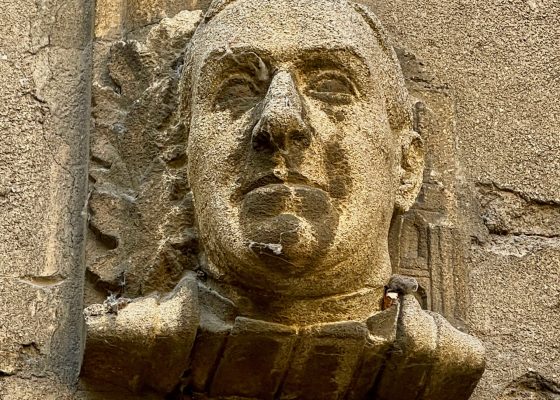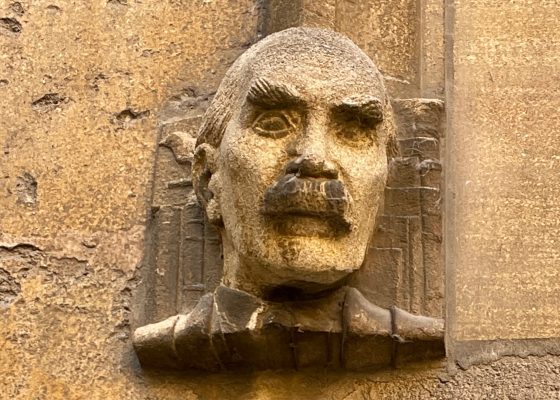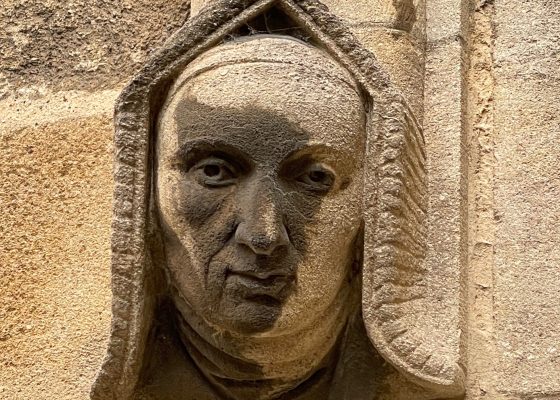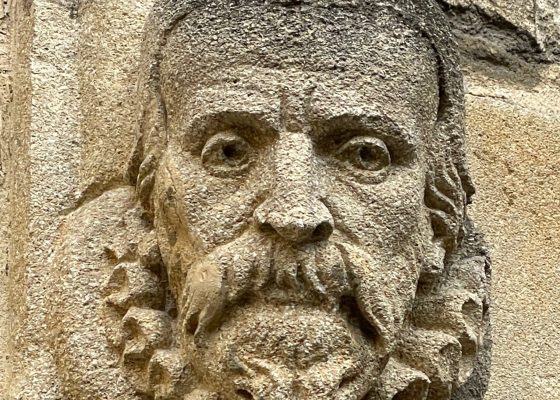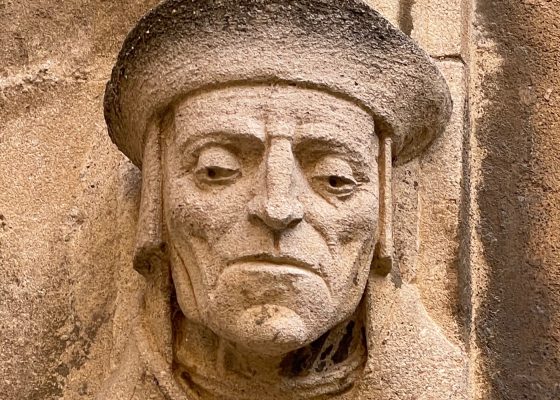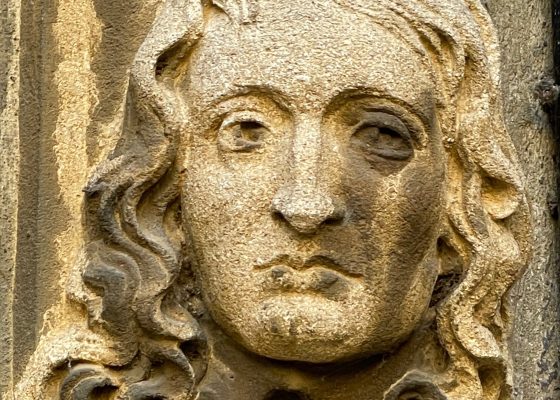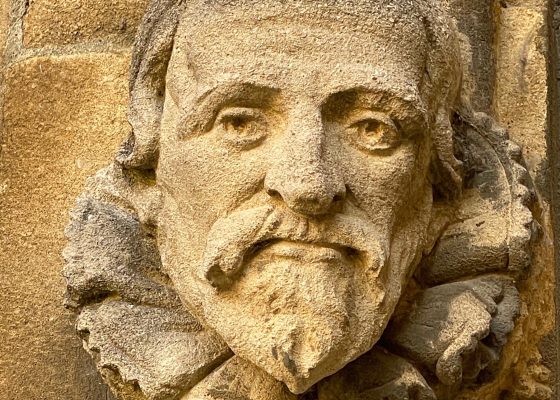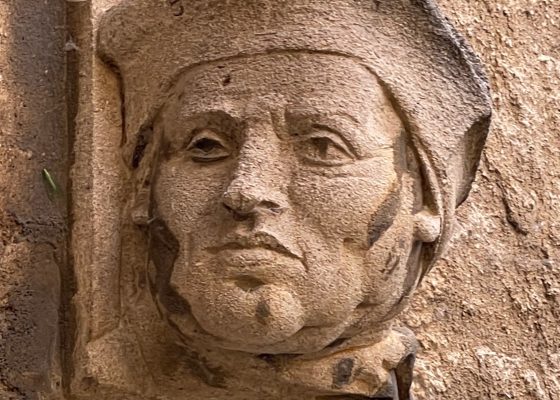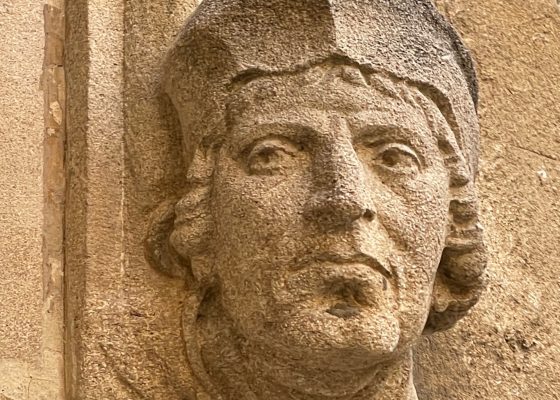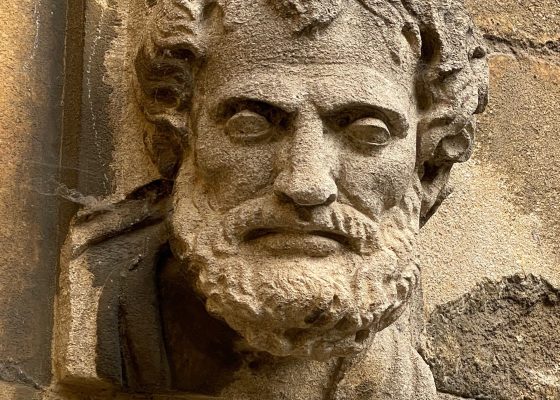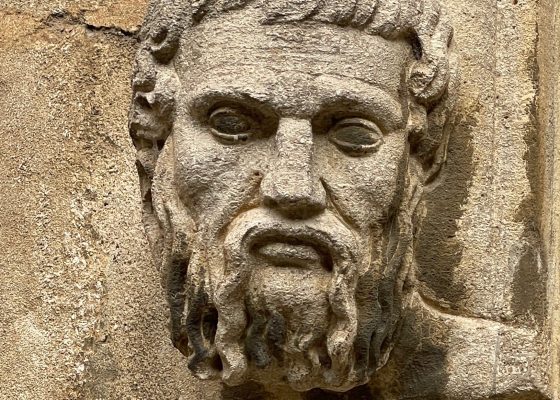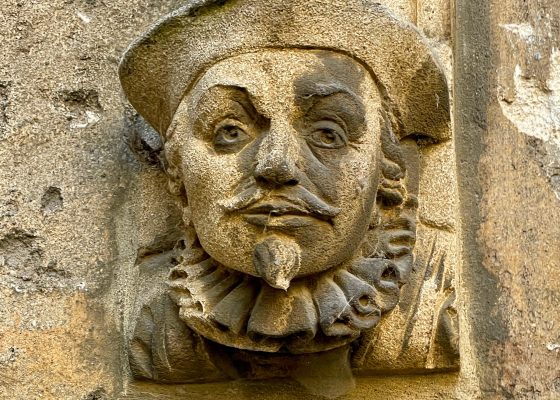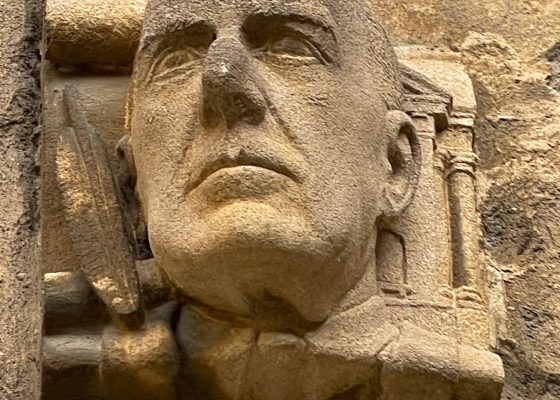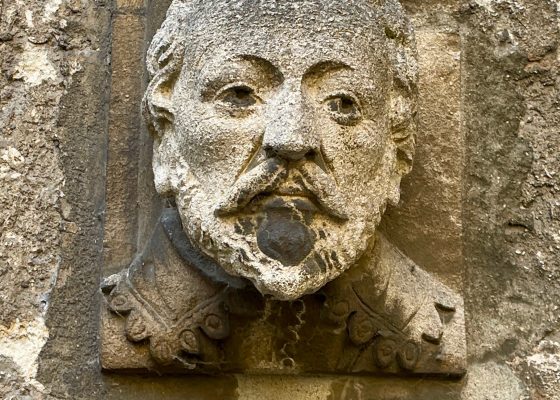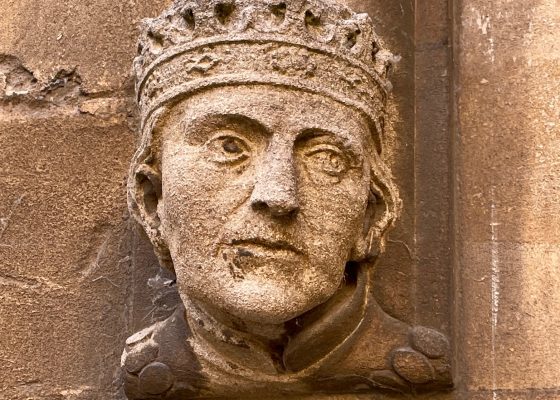Oxford Walking Tour with Andrew Parker
In my last post from England my friend Don Harding and I enjoyed travelling along the Thames by boat to Greenwich and back on what turned out to be a great day in London. The next morning we were driven to Oxford by private car which turned out to be much quicker and more efficient than using public transportation. At £80 it was also only marginally more expensive. We used the services of Airport Pickups London and I highly recommend looking at this as an alternative, especially if you are hauling around golf clubs as Don was. Our purpose in coming to Oxford was to discover the place on a guided Oxford walking tour which I’ll get to shortly, but first a few words about a great Oxford hotel.
The Malmaison Oxford
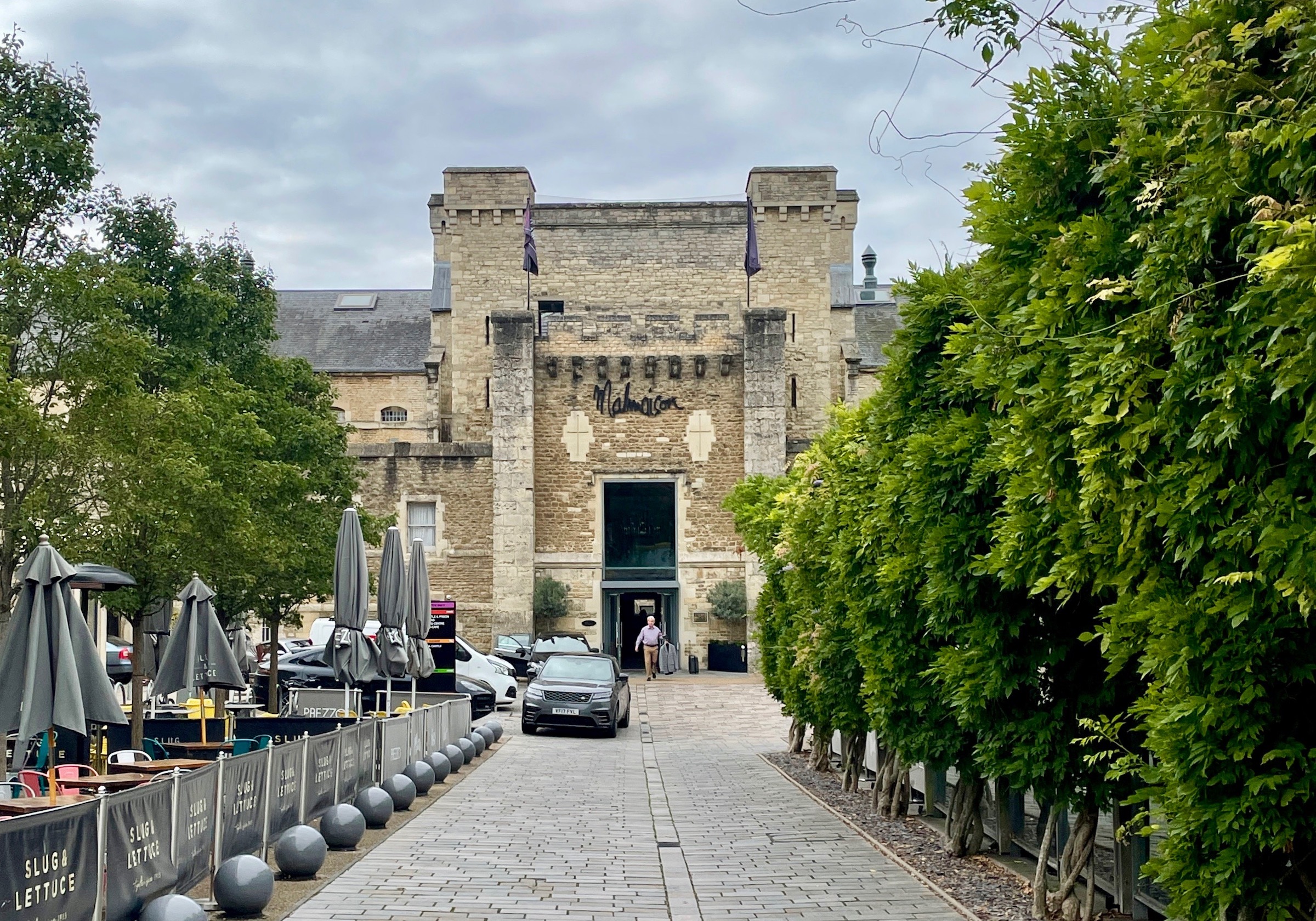
Our initial destination in Oxford was the Malmaison hotel which is actually located inside the former prison at Oxford Castle. I chose this place mainly because I was intrigued by the idea of staying in a former prison cell, but it was also highly recommended on Trip Advisor.
The Malmaison was a great choice and turned out to exceed our expectations in every way. If you’ve ever visited a prison or God forbid been an inmate you will recognize the standard prison layout.
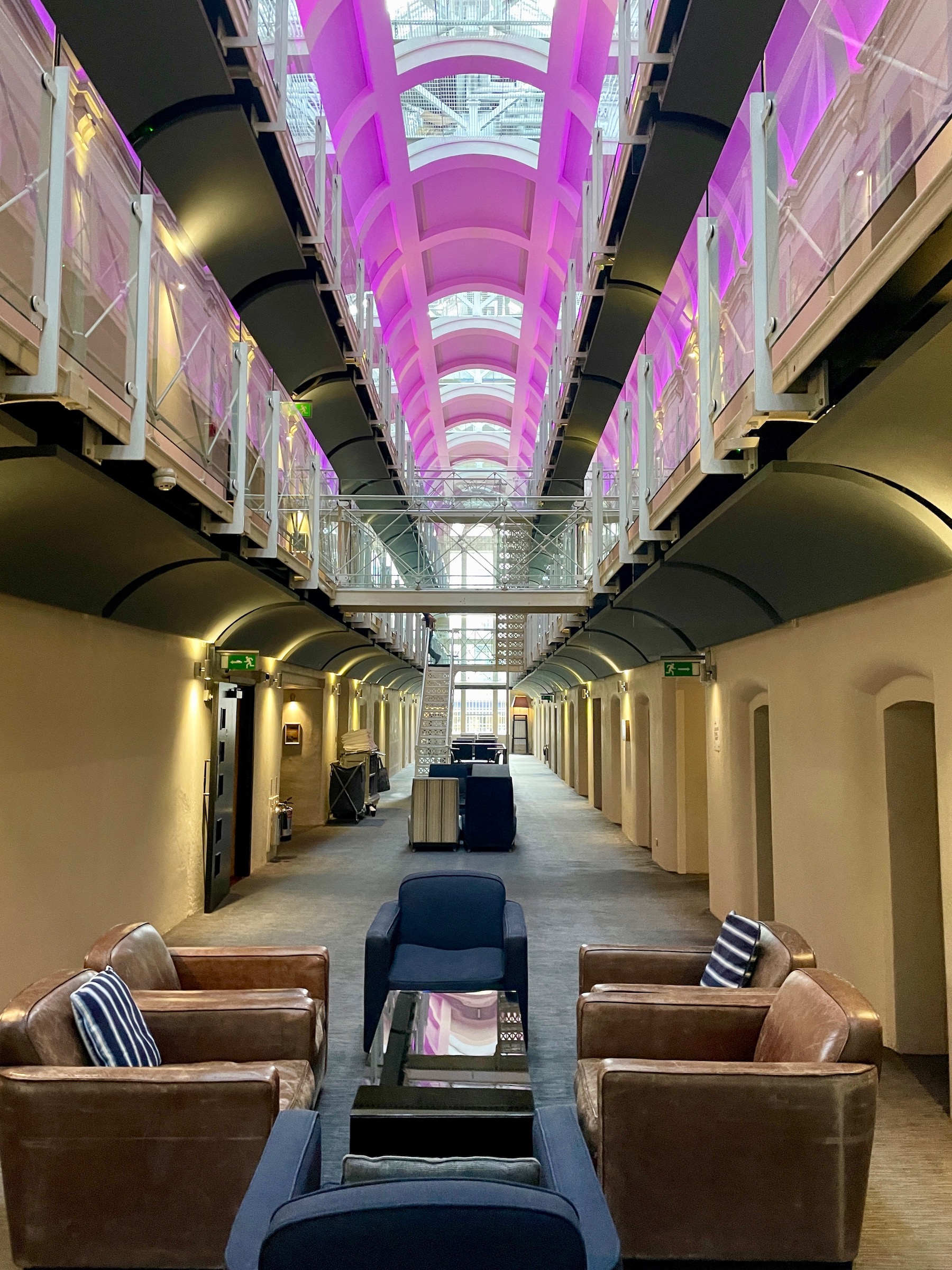
Each room was actually composed of three former cells with the bathroom occupying one cell and the bedroom the other two. Luxury in a prison, who knew?
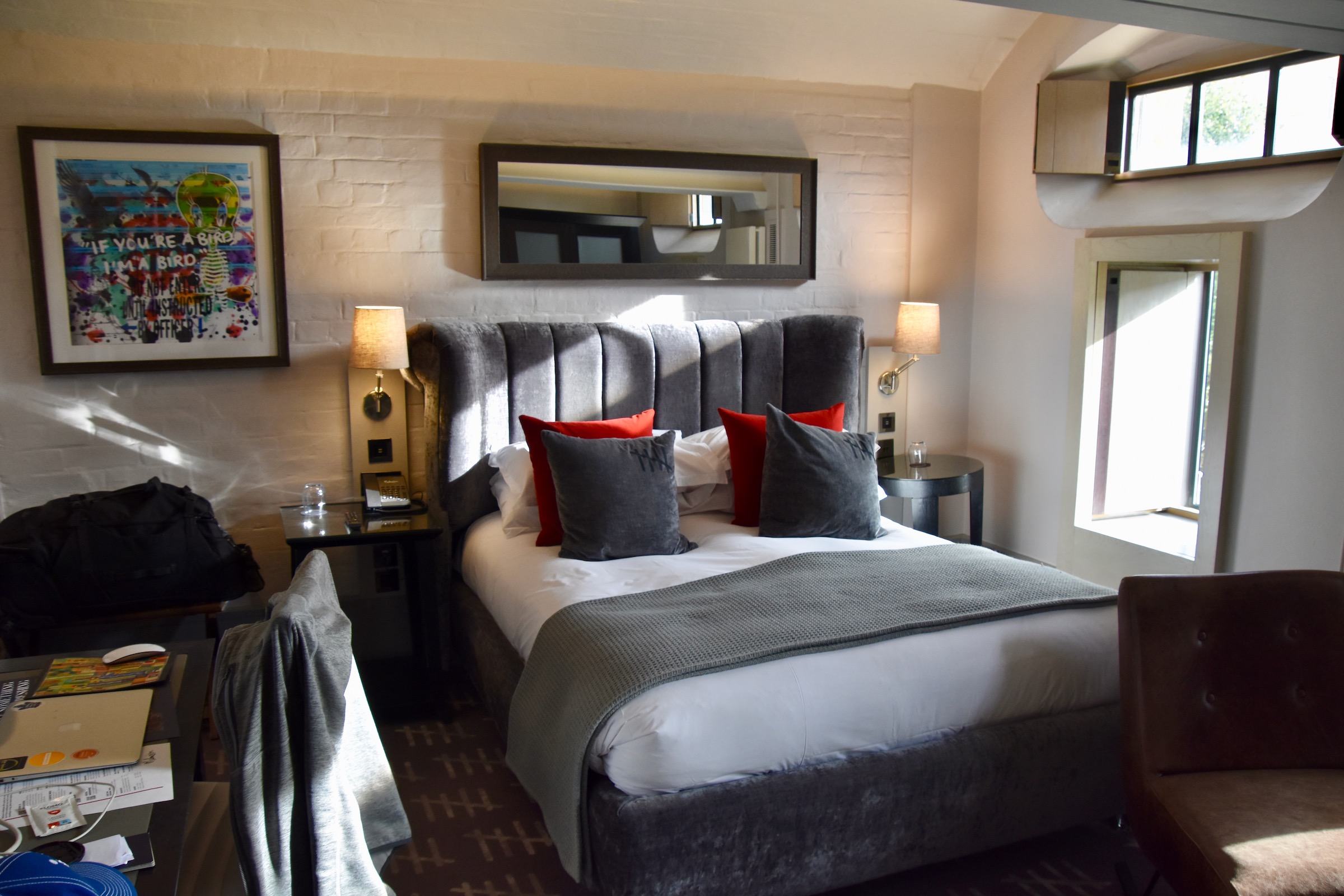
We had arrived early and still had time for breakfast in the Chez Mal restaurant. The full English breakfast was filling to say the least and provided the calories we would need to burn off on our Oxford walking tour.

Oxford Walking Tours
I had pre-booked a 90 minute walking tour through Oxford Walking Tours which has been in business for 30 years. The cost was £18.95 for seniors.
Despite travelling from London to Oxford and eating a hearty breakfast we still had some time before our allotted time so Don went wandering and I took a seat outside The King’s Arms, one of Oxford’s venerable pubs, dating back to 1607.
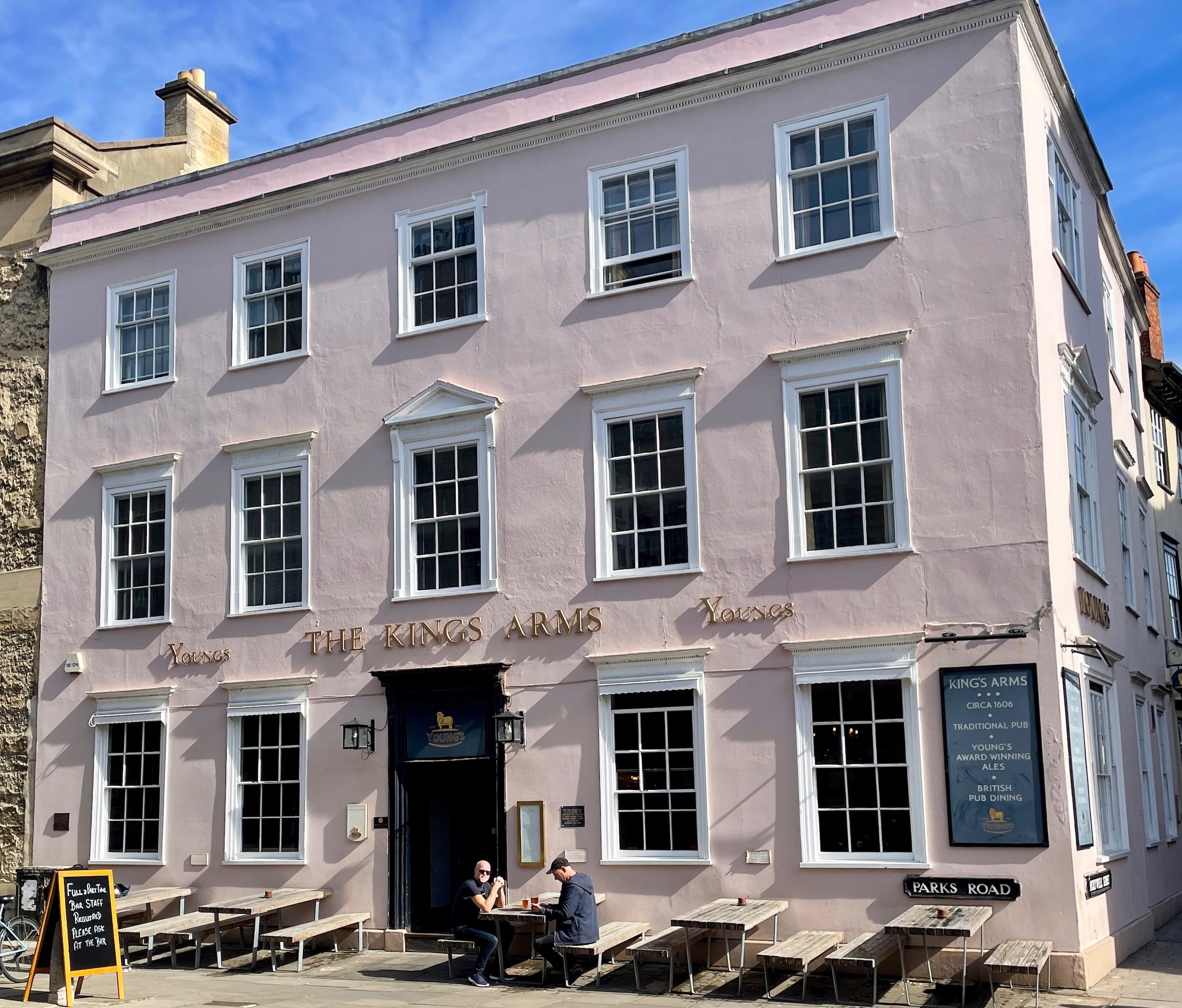
As you can see from the guy in a tee-shirt, it was a lovely autumn day in Oxford. I grabbed a pint of a cask ale, (I forget which) and watched a parade of antique cars drive by in an Oxford Sunday ritual.
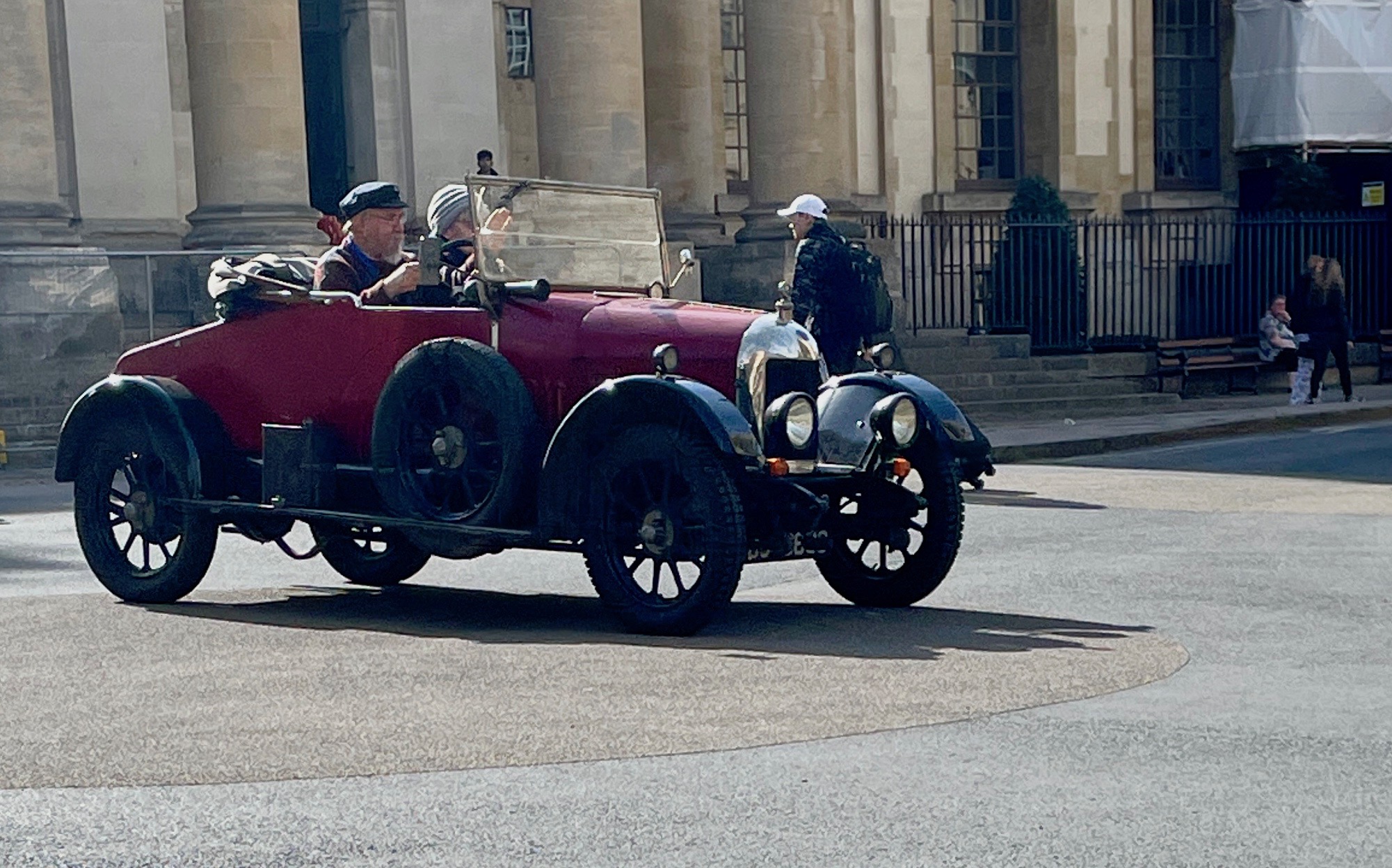
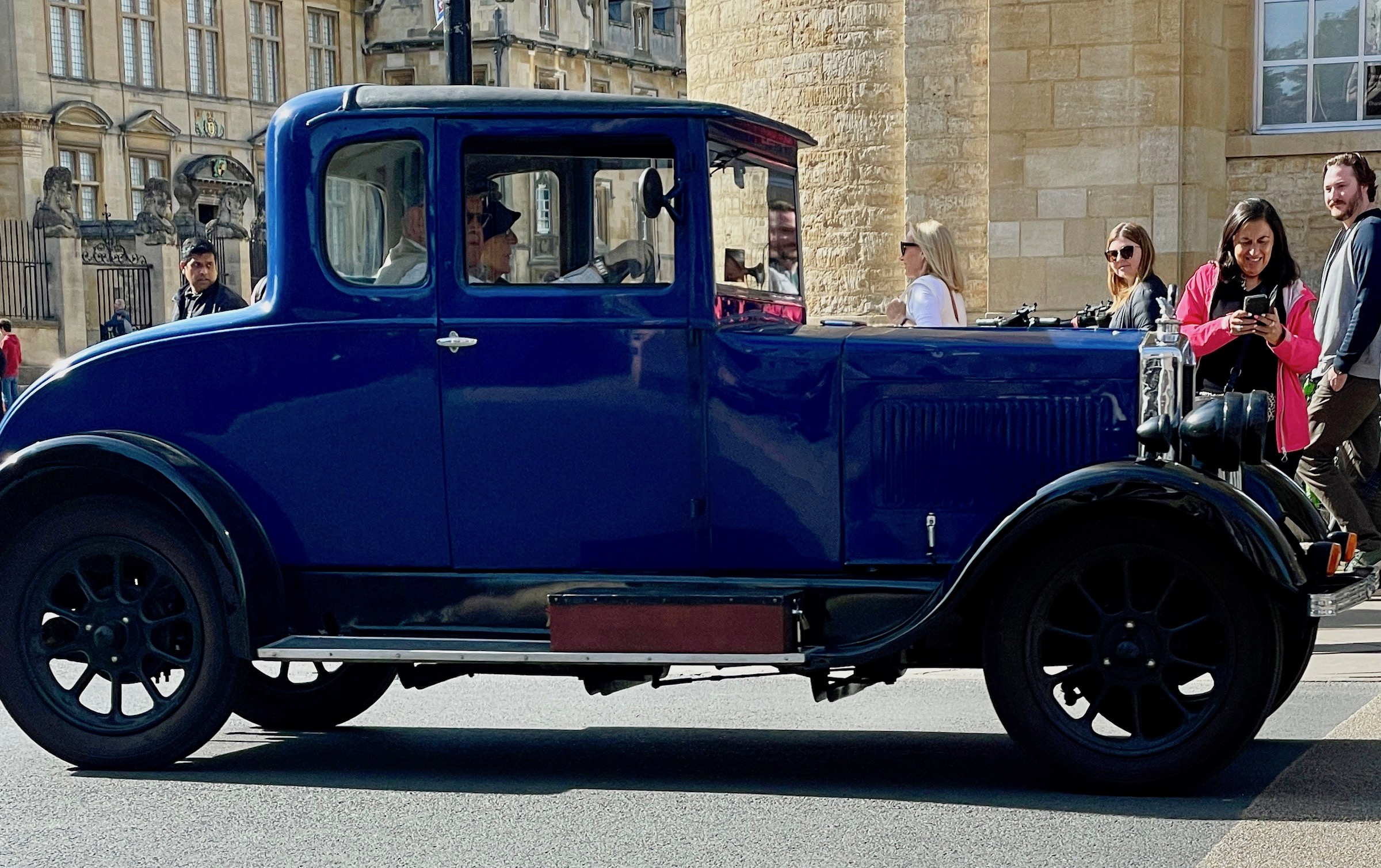
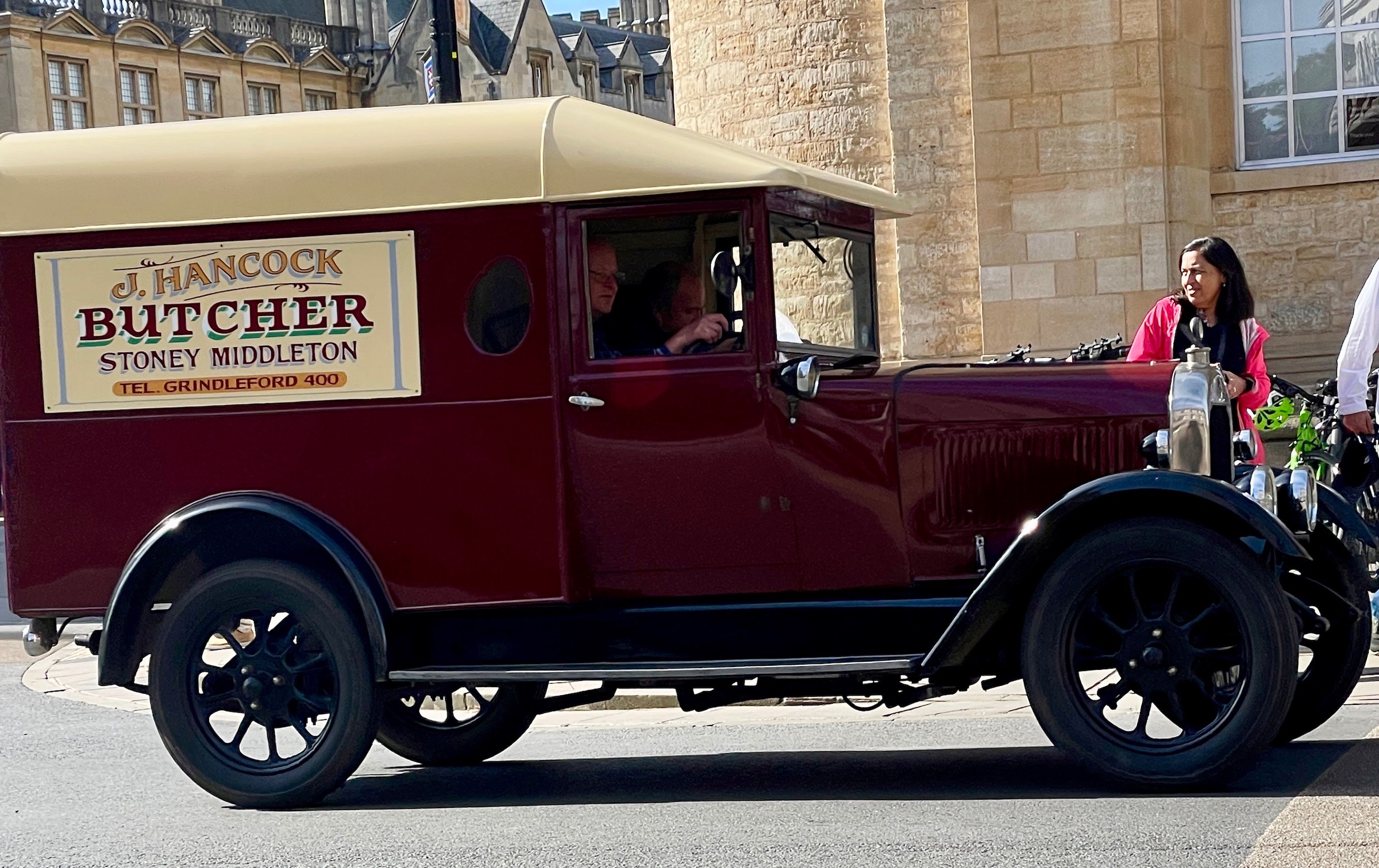
At 1:00 we met our guide Andrew Parker in front of the gates to Trinity College and it turned out it was just Don and I on this tour. I had been to Oxford a few years earlier with my friend and former client John Easling. The purpose was to meet with Richard Webster author of The Secret of Bryn Estyn and a number of other books detailing the horrors of being falsely accused of child abuse. Not only did we meet Richard, but he invited us to stay at his house which backed on the Oxford canal. Sadly, Richard died a few years after our visit, but his books continue to set the standard for true investigative journalism in an area that few dare to tread.
On that visit I saw enough of Oxford to know I had to come back and learn more about its famed colleges that collectively make up the University of Oxford. Despite being gassed at the Western Front in WWI my great uncle John Dunlop won a Rhodes Scholarship to Oxford which he parlayed into a legal career in New York City with the prestigious firm headed up by Elihu Root. I once had a picture of him at a large dinner gathering at Oxford with H.G.Wells and ever since wanted to know more about Oxford university life. As it turned out Andrew was the just the man for the task and our first stop on the Oxford walking tour was one of the oldest of the colleges, Balliol.
Balliol College
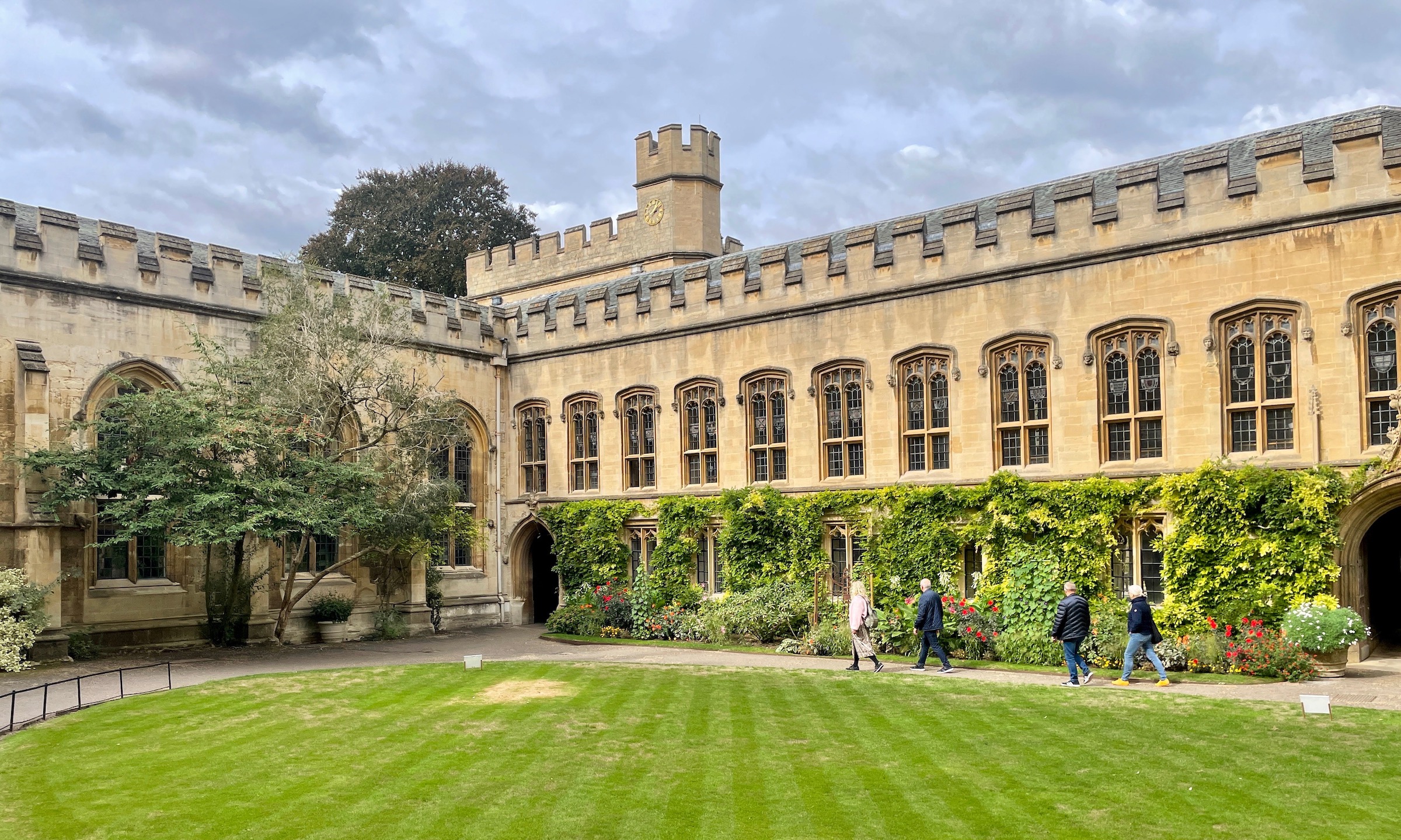
Oxford University is not a university as we would think of in North America, with one campus composed of various faculties. Instead it is a collection of over thirty separate colleges that collectively form the University of Oxford which has a central administration, but technically has no students that are not affiliated with one college or another. The teaching method is quite different than that in North America. Students live within the walls of their college and are each assigned a tutor for the duration of their stay. The student along with only a few others learn through tutorials rather than just attending lectures. It is an all encompassing experience that includes communal meals, sports activities, social clubs and more.
Balliol College is the perfect place to learn more about the Oxford academic life and as it is Sunday, it is open to the public. I should note that only a few of the colleges permit tourist visitors and then only at selected times for a set fee.
Founded in 1263 by the husband and wife team of John and Dervoguilla Balliol, it is one of the oldest of the Oxford colleges, some claim the oldest. The list of prominent alumni is lengthy and to list only a few include the economist Adam Smith, Prime Ministers Asquith, MacMillan, Heath and Boris Johnson, authors Aldous Huxley, Graham Greene and my favourite Canadian author Robertson Davies, poets Matthew Arnold, Hillaire Belloc, Gerard Manley Hopkins and Robert Southey, film director John Schlesinger of Midnight Cowboy fame and in my opinion two of the greatest minds of our current age, Richard Dawkins who is still affiliated with the university and the late Christopher Hitchens. Two notables who didn’t graduate are Bill Clinton and Tony Blair. Even fictional people like Captain Hook and Lord Peter Whimsey attended Balliol.
So walking into the outer close of Balliol Don and I are in the presence of many greats from the past and present.
Andrew points out four interesting small sculptures representing four stages of the student experience. The first is the good pupil, studiously reading his text.
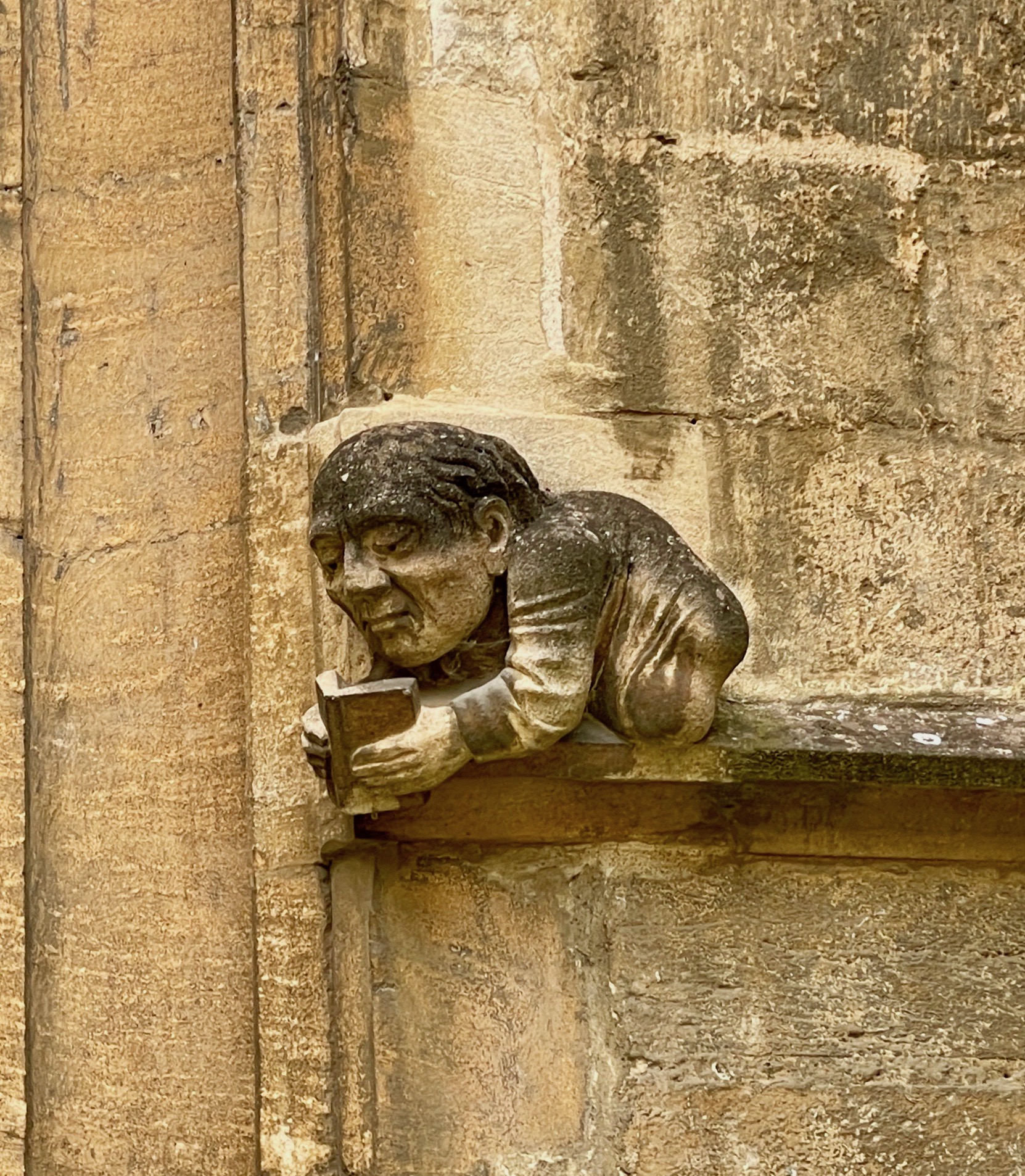
The second is of the bad student who wiles away his time drinking when he should be studying. Sounds a bit familiar.
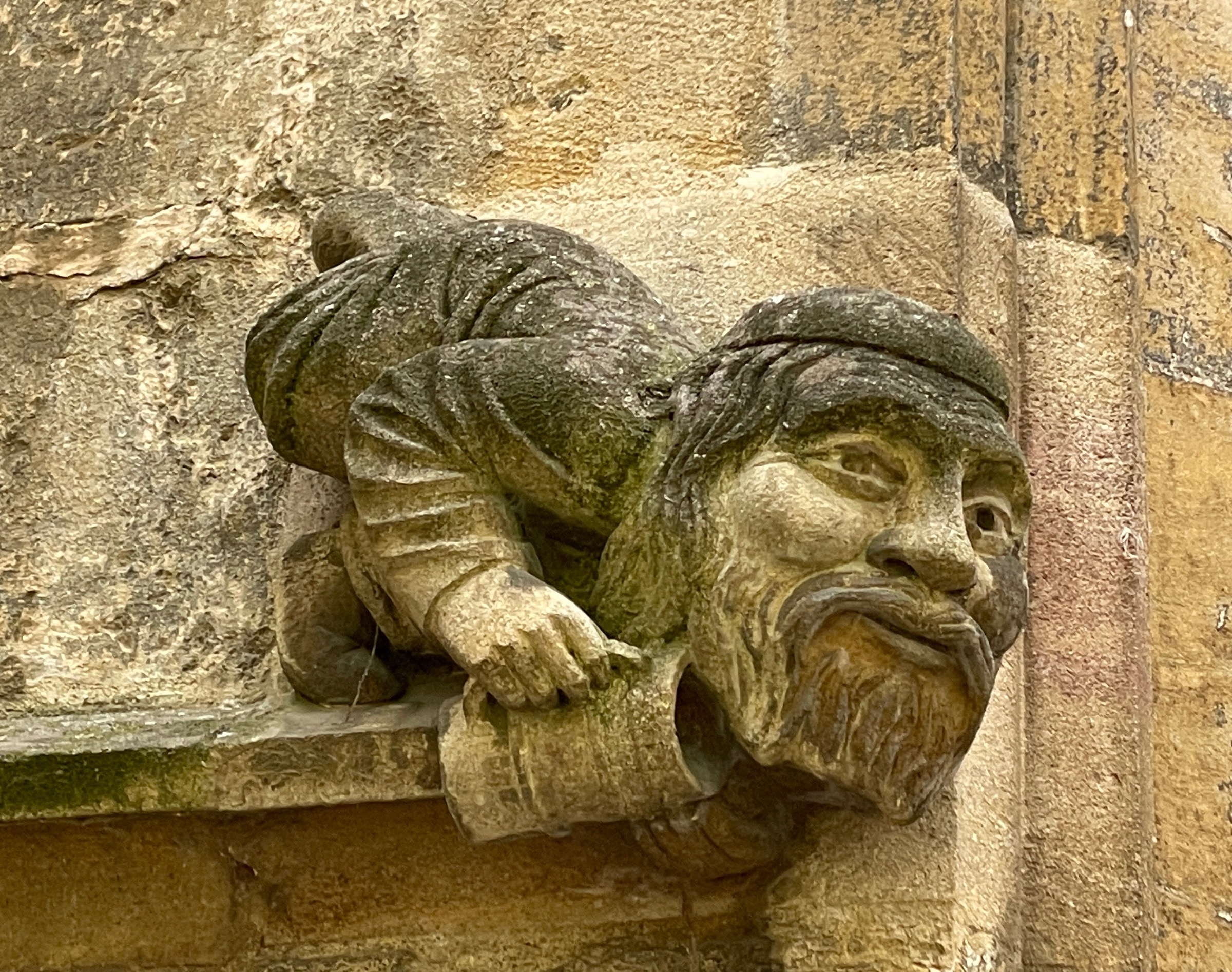
The third is a consequence of the second, sticking his finger down his throat to puke his guts out. Also sounds familiar.
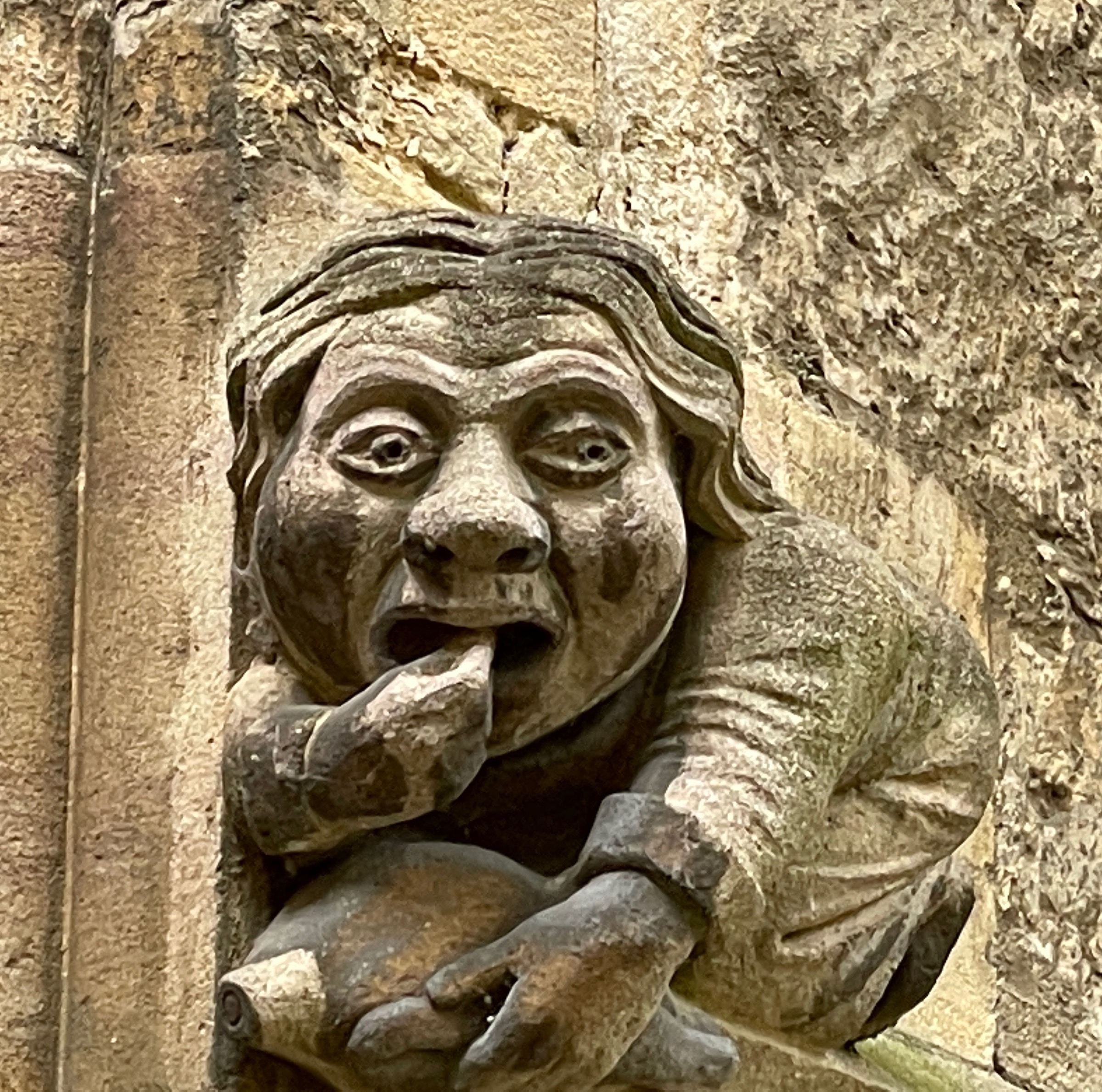
The fourth is a likely outcome for the first but not the other two – a graduate.
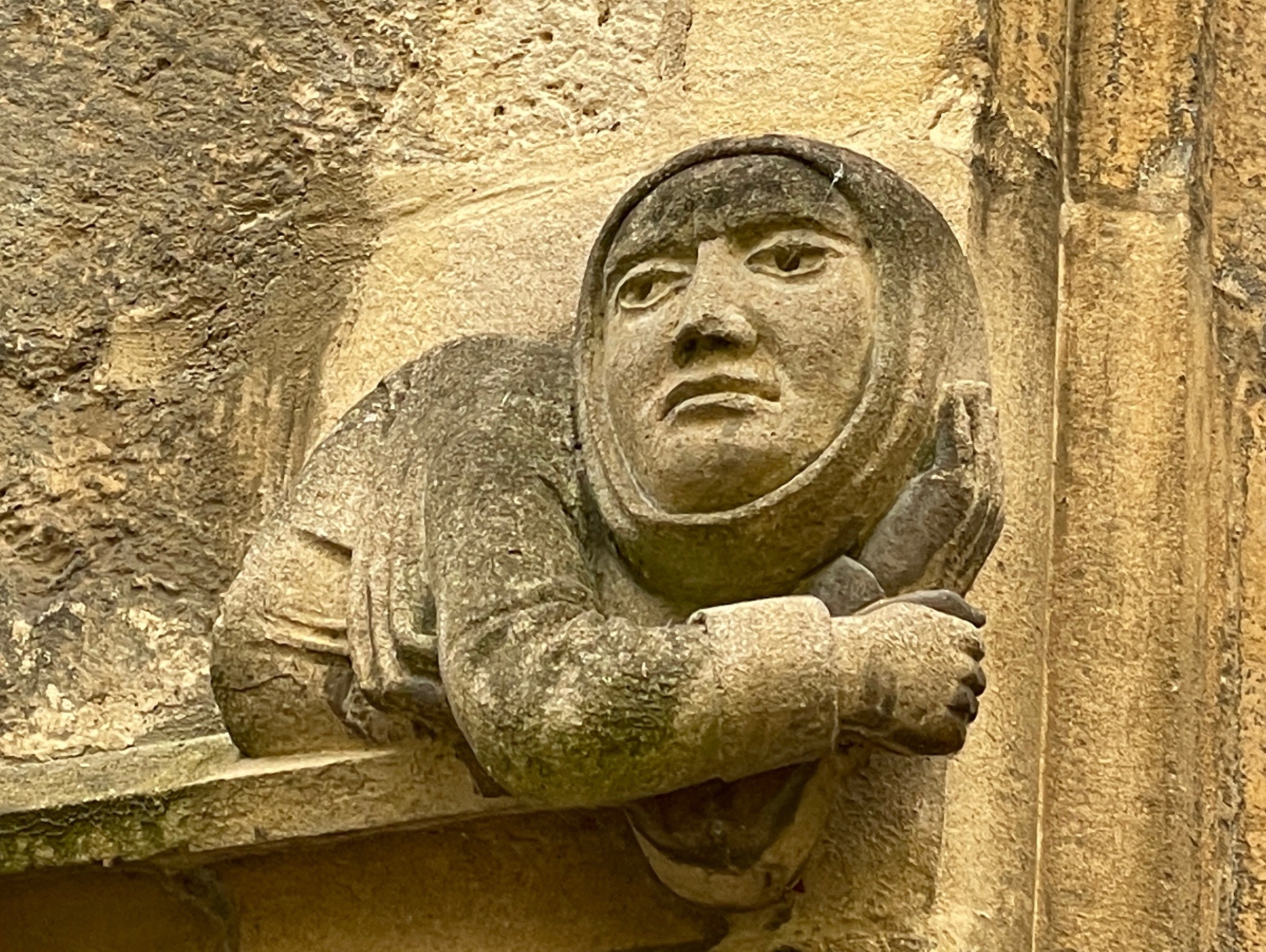
Although almost all the colleges at Oxford started out as religious institutions there was still room for a little whimsical levity.
We pass from the small outer close into the main quad which is surrounded by gardens that seem to include some very banana like trees if that’s possible.
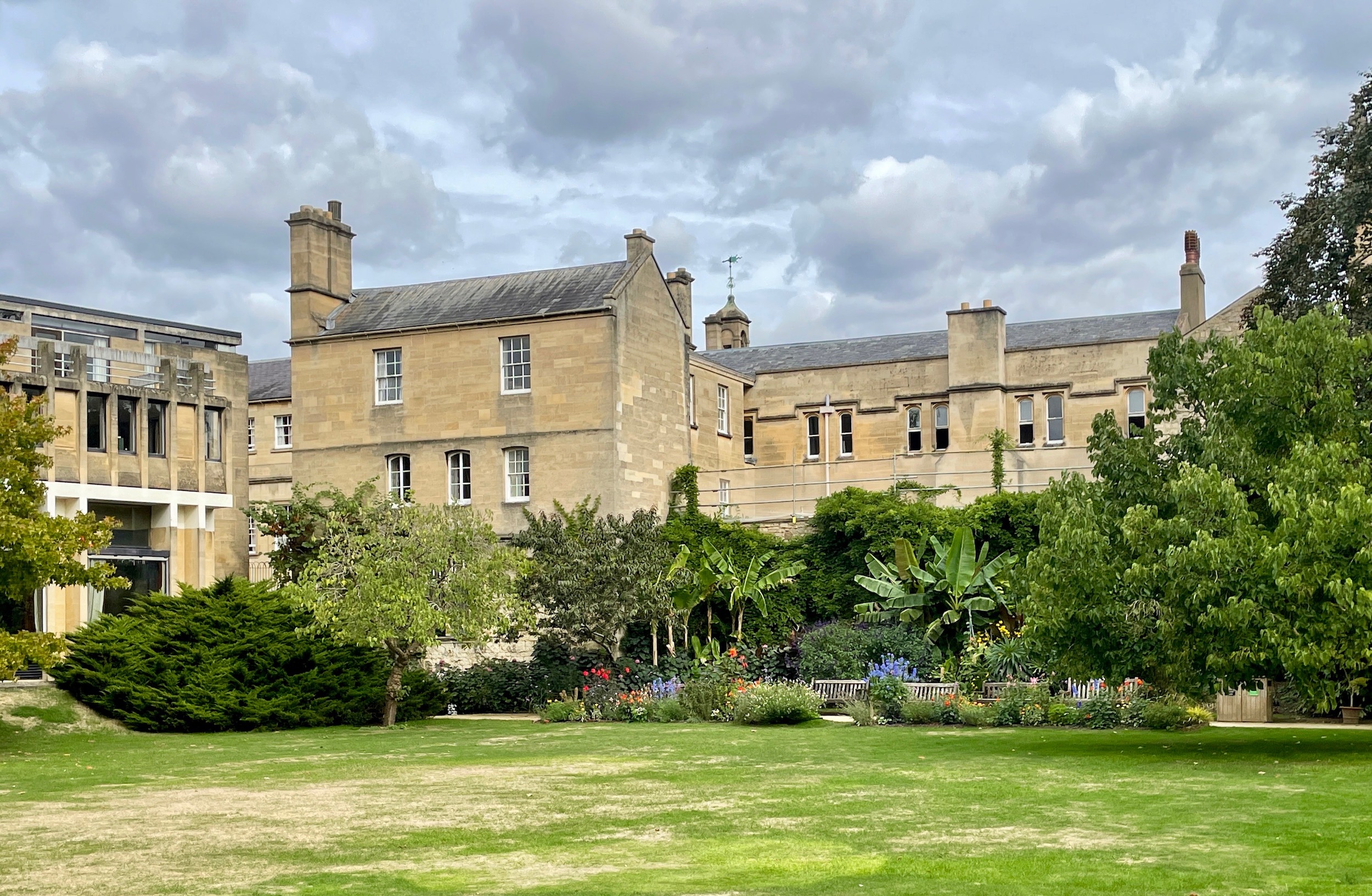
Don and Andrew engage in conversation just as thousands of notables have in the past.
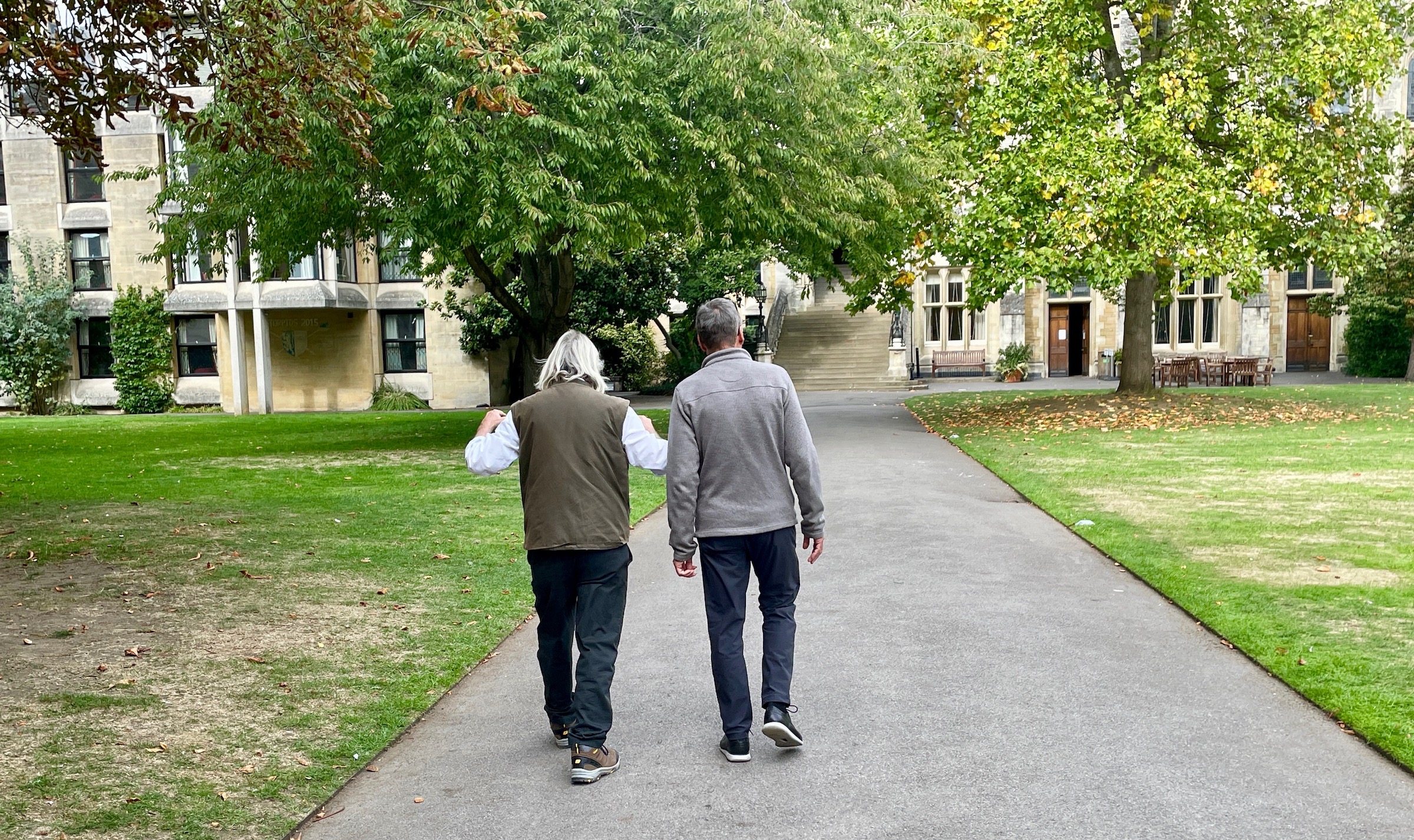
From the quad we make our way into the Grand Hall which is very similar to the one in the Harry Potter movies which was based on the nearby Christ Church hall. Having seen the movie set outside London a few years ago I can definitely see the resemblance.
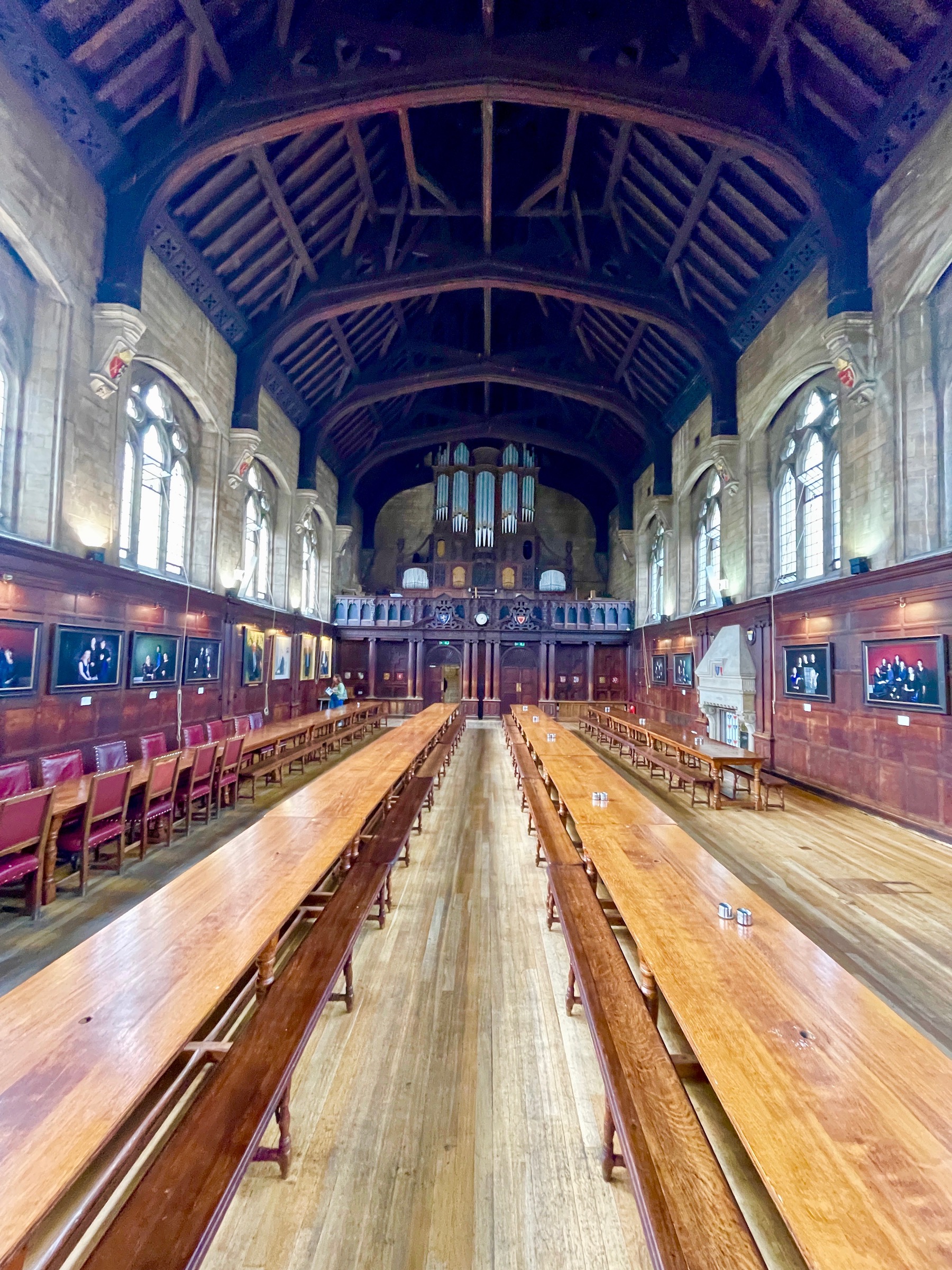
This is the Don’s Table at the head of the room with the portraits of the former Head Don’s looking down at the student body. The place palpably reeks of tradition and I mean that in a good sense.
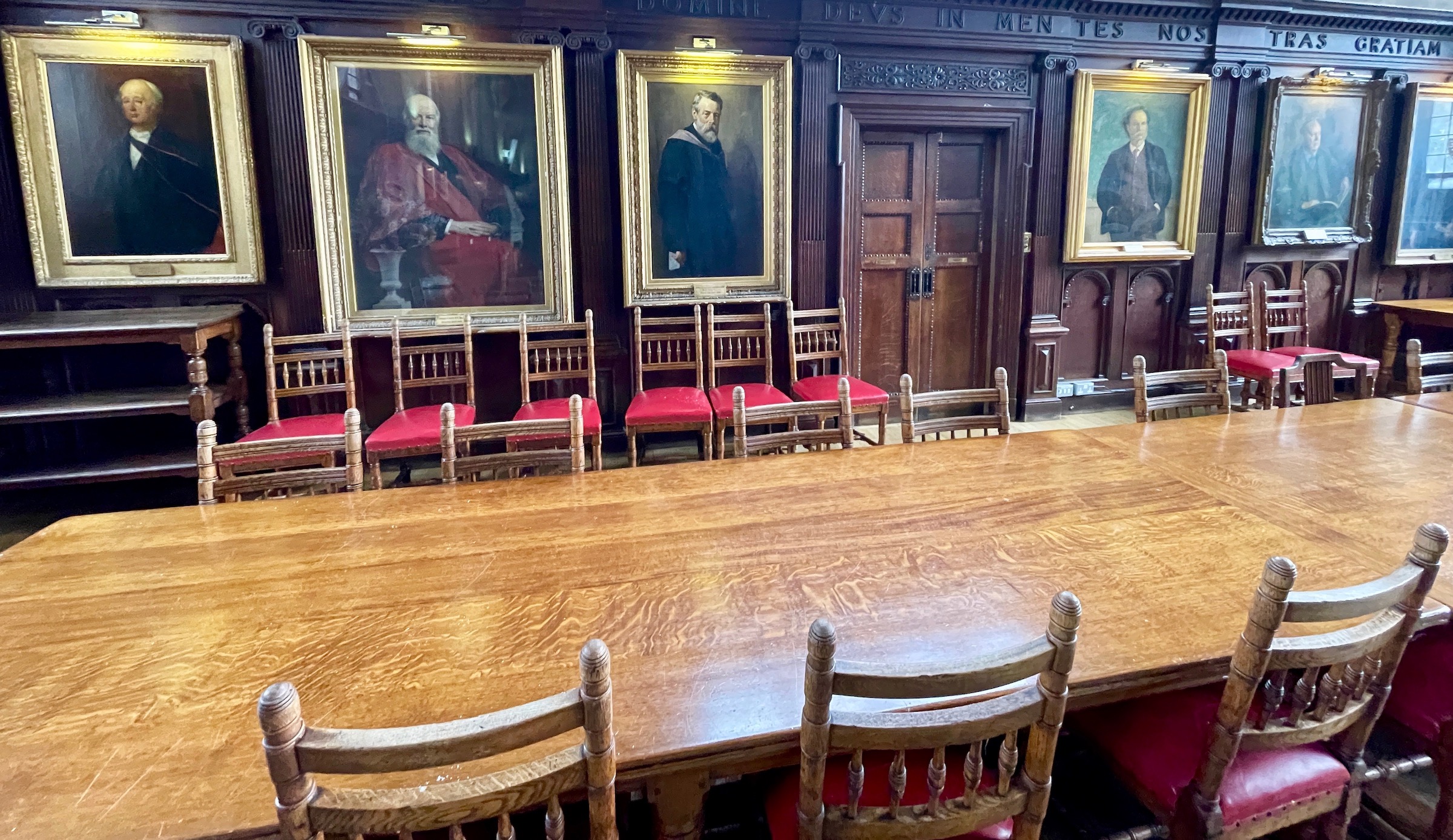
Back in the quad we make our way toward the Italianate Chapel which dates from 1857 and is the third built on the site. Architect William Butterfield’s design was so badly received that an offer was made in 1912 to have it torn down and replaced, which was not accepted. That’s the chapel on the left with the alternating colour scheme such as you might see on the duomo in Florence.
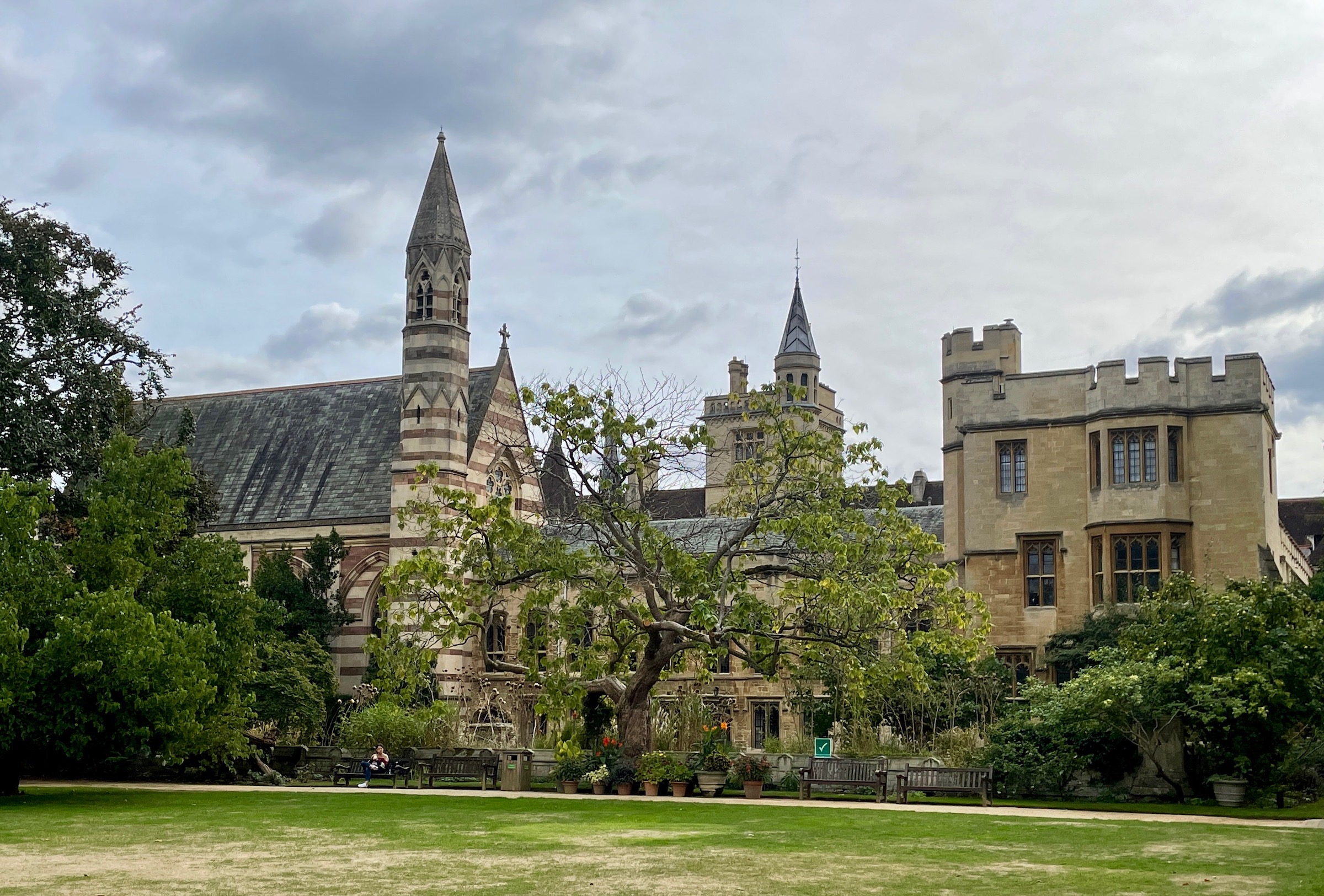
Inside the chapel has some very nice stained glass that was preserved from the second chapel and dates back to 16th and 17th centuries.
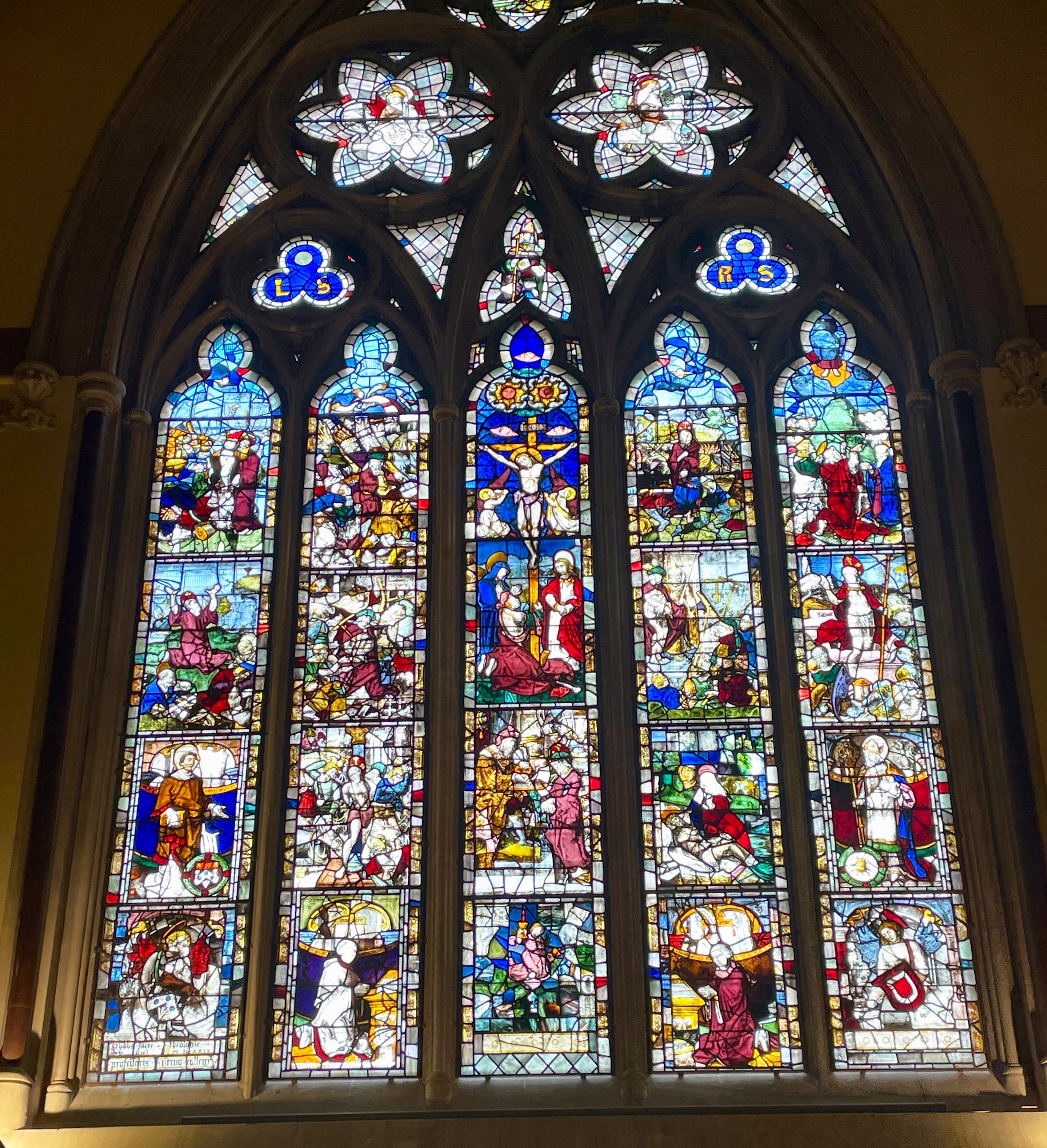
Andrew points out this most interesting object which is a crowned brazen eagle lectern from about 1630. What sets it aside from other similar lecterns is that during the Puritan Revolution Oliver Cromwell had the poor creature beheaded as a symbol of idolatry. Fortunately, someone saved the head and after the Restoration the eagle also had his head restored.
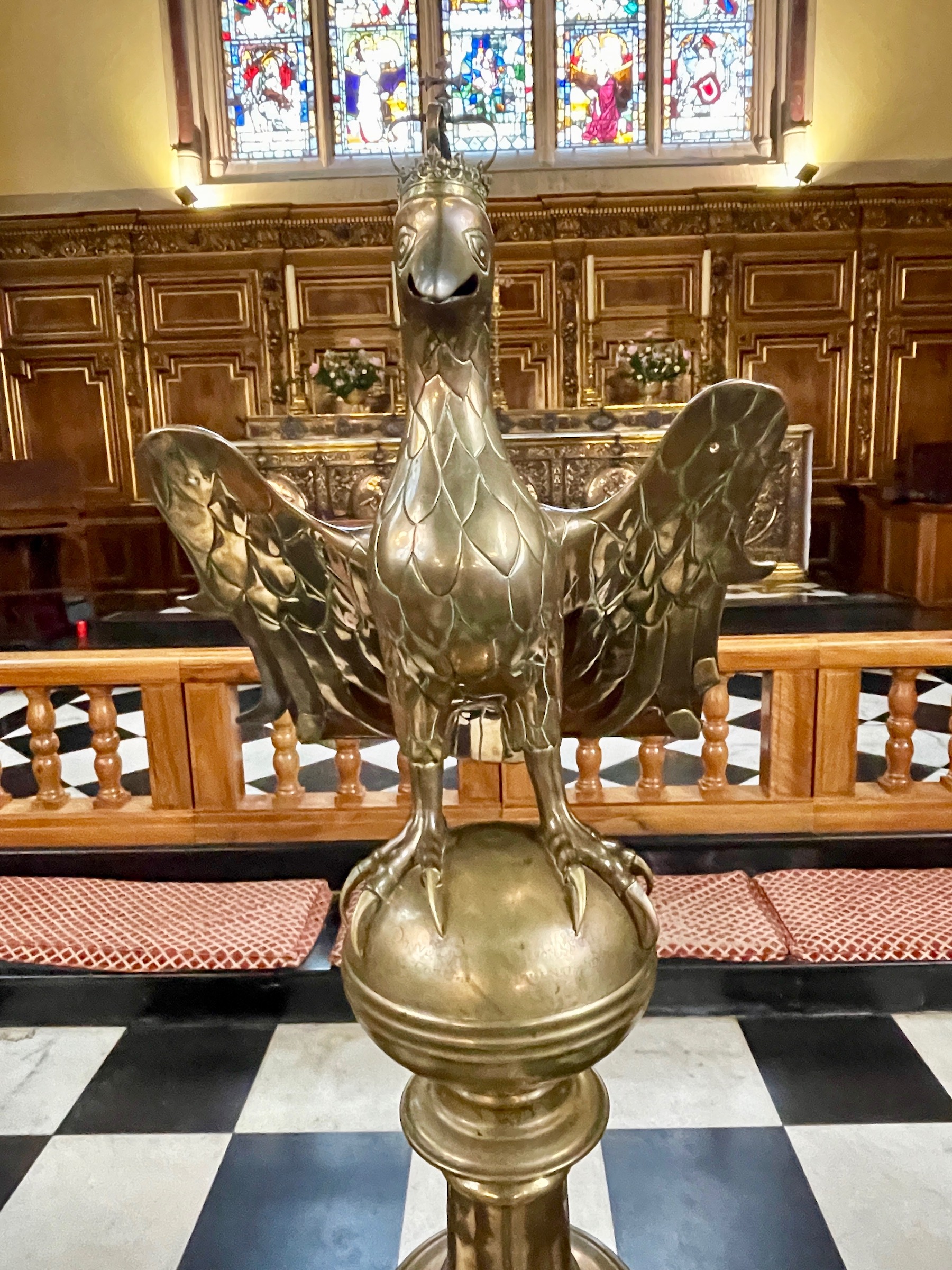
Back on Broad Street we continue our walking tour of Oxford passing by this unpaved square which Andrew tells us marks the very spot where the Protestant martyrs Hugh Latimer and Nicholas Ridley were burnt at the stake as heretics on October 16, 1555. Before their trial, which was a foregone conclusion, they were housed in the Oxford prison, which of course is now the Malmaison Hotel where Don and I are staying. Who knows, we might have shared the same room with them?
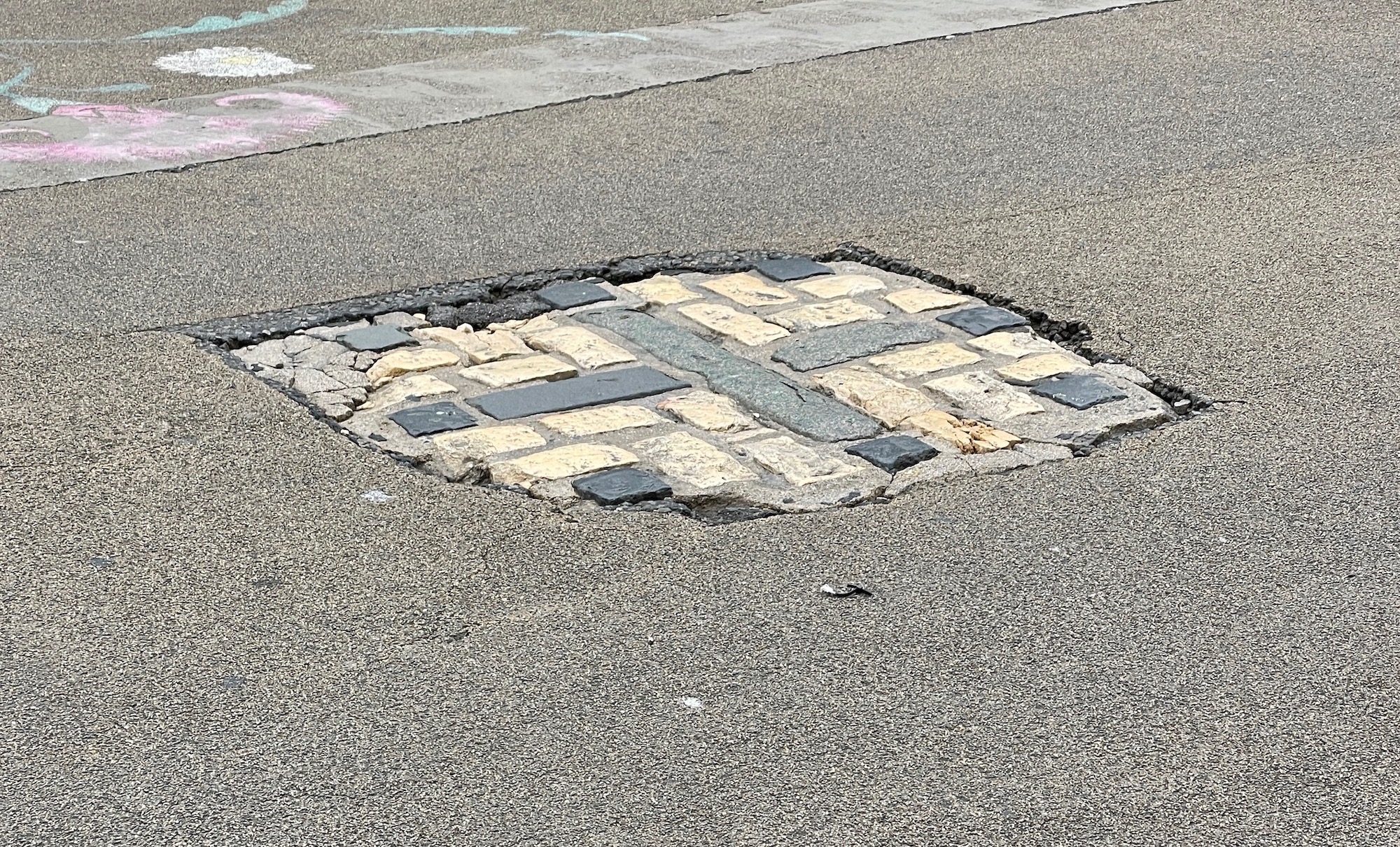
There are any number of sights along Broad Street of note and you could spend an entire day just exploring this small area. This is the tower of Exeter College where J.R.R.Tolkien studied. It later became the inspiration for the dark tower in the Lord of the Rings trilogy. Tolkien was an Oxford denizen and there are many places in Oxfordshire that feature in his fantasy writings.
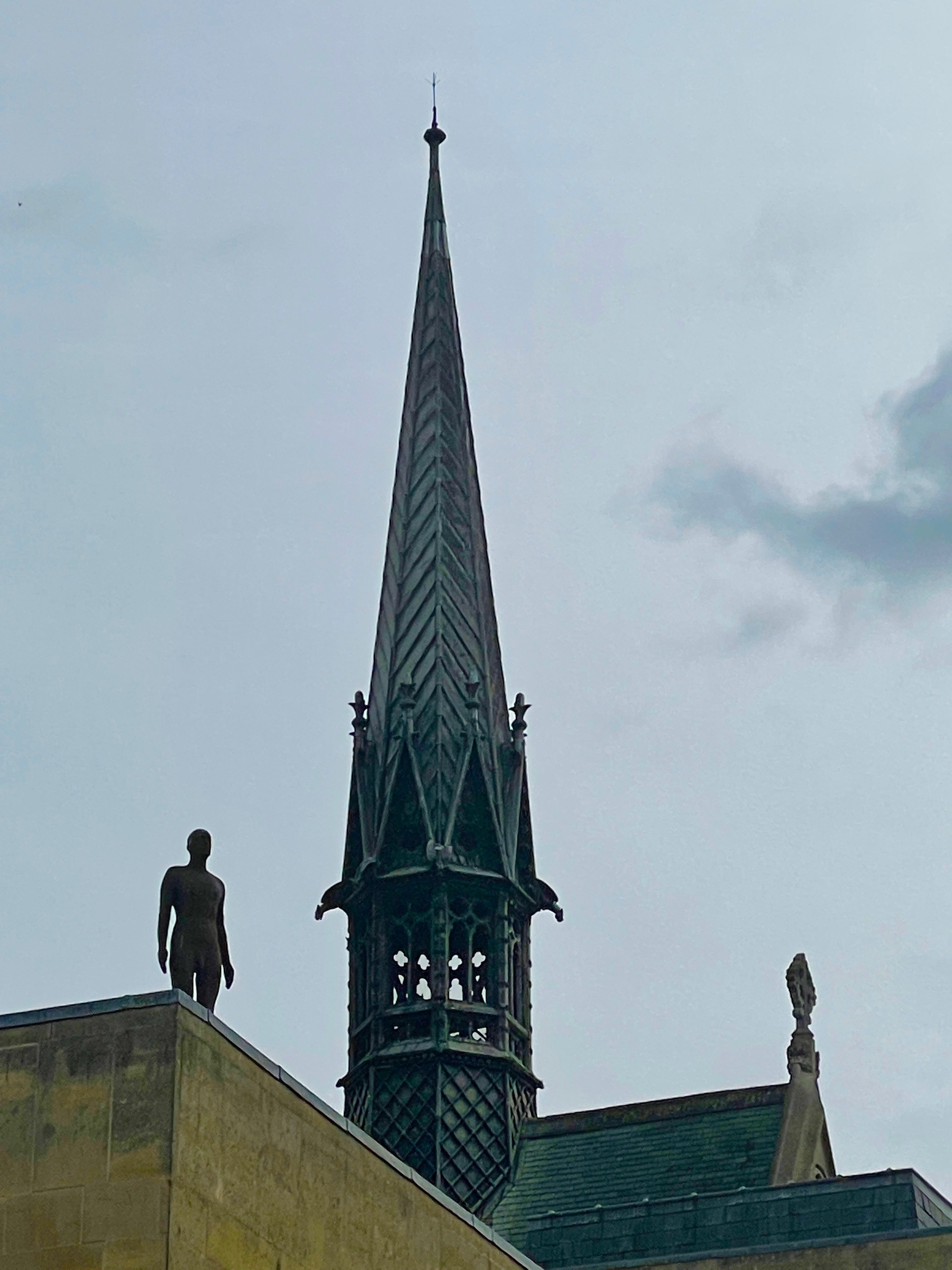
While Inspector Morse is a fictional character you would not know that based on the many real places in Oxford that feature in both the books and the iconic TV series. In the final episode of the TV series Morse has a heart attack while listening to the Exeter College choir and stumbles out of the chapel and dies on the quad.
On a happier note he could often be found quaffing a cask ale at the White Horse pub on Broad Street.
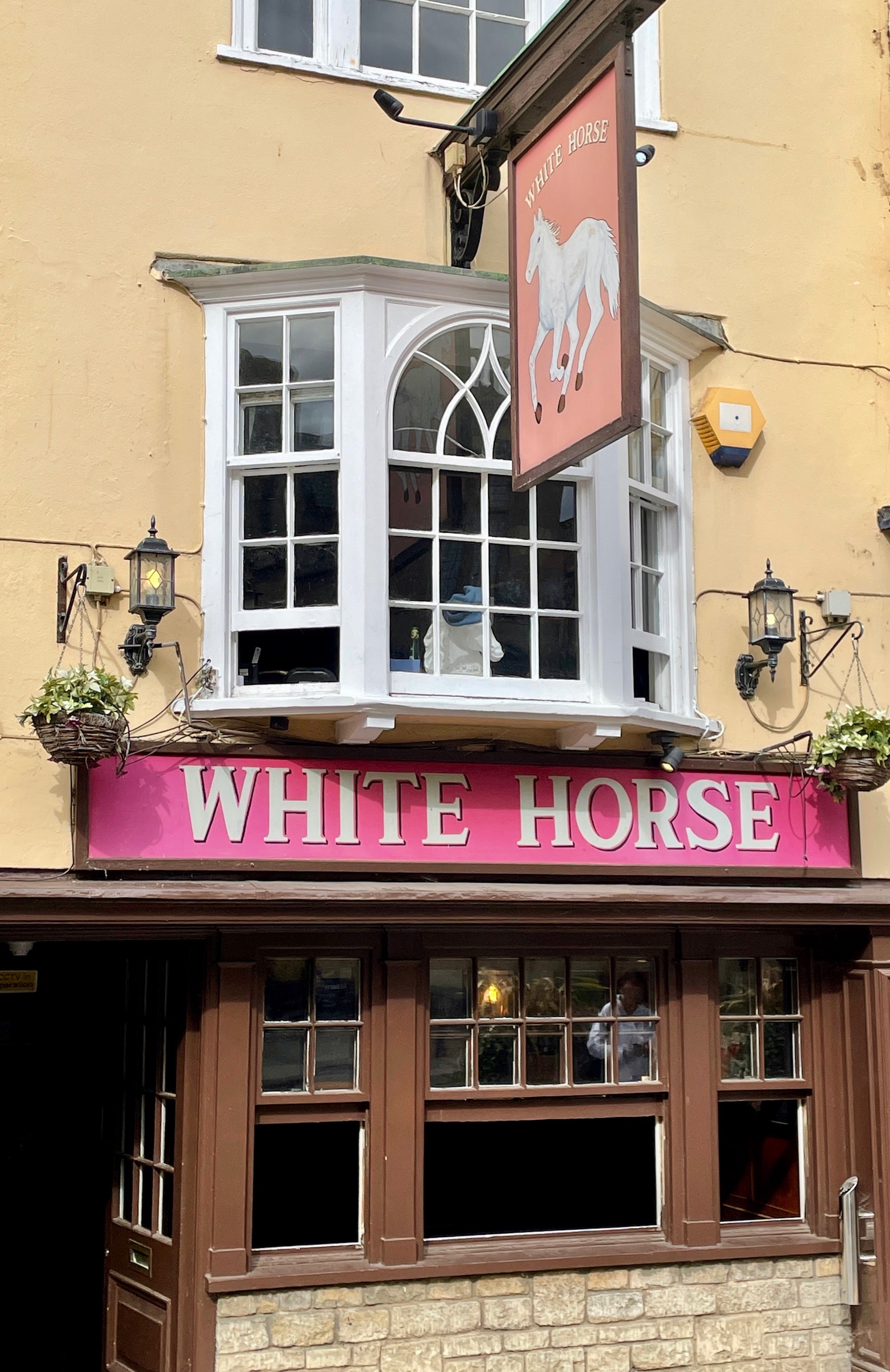
Almost next store is one of the most famous bookstores in the world, the flagship location of Blackwell which was founded in 1879 and remained in the family until February of 2022 when the chain was acquired by Waterstones. While you can’t tell from the outside, the place is massive inside with the Norrington Room containing over three miles (5kms.) of shelving and over 160,000 books, the largest such room in the world. Buying books at Blackwell is as much an Oxford student tradition as reading them in one of the many nearby pubs and cafes.
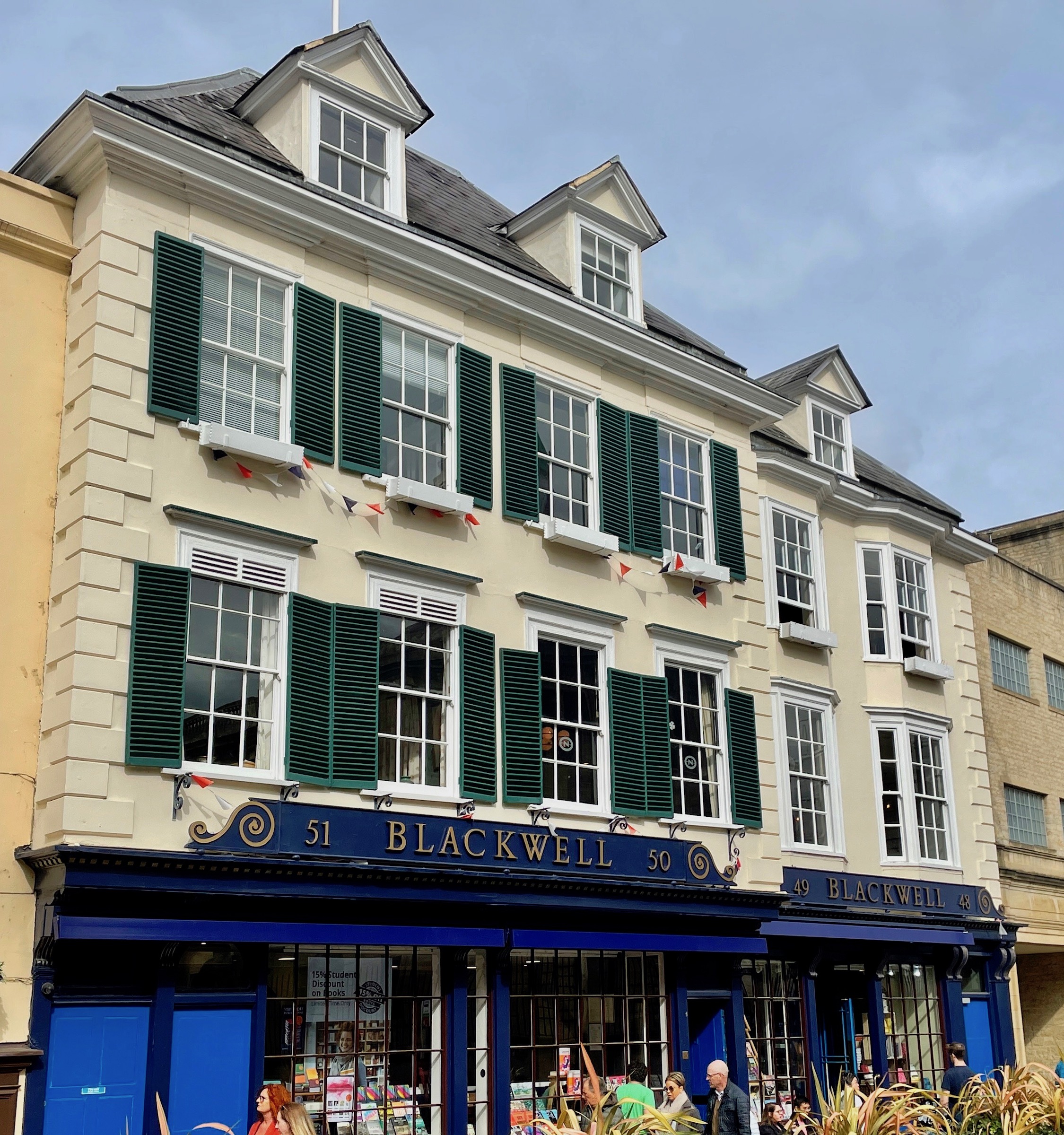
Time for some interesting architecture. I did not know until Andrew told us that the great British architect Sir Christopher Wren got his start in Oxford. In my last post from Britain Don and I saw his masterful work at the Royal Naval College in Greenwich. He was a graduate of Wadham College and in 1664 was given his first major commission, the Sheldonian Theatre which Don and Andrew are standing in front of. At the time Wren was actually a Professor of Astronomy and had only one minor commission to his name, the chapel at Pembroke College in Cambridge for which he had been hired by his uncle.
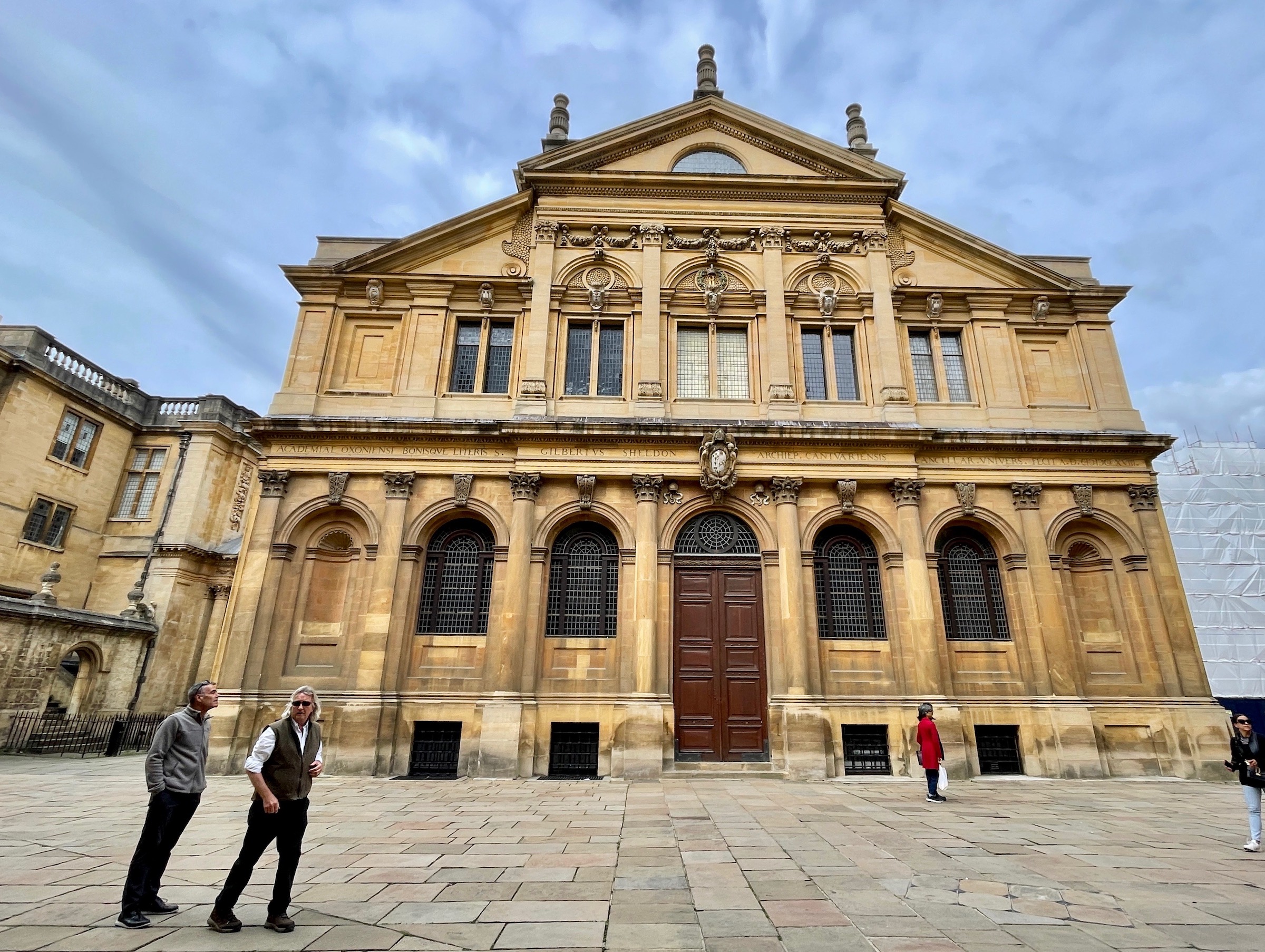
It was the Sheldonian, based upon the configuration of a Roman theatre, but with a roof instead of open air that made Wren’s reputation. Today it is the principal assembly room for Oxford University and this is where every graduate receives their degree. At the rear of the building are a series of giant sculpted heads that are among the most intriguing things that one can see in medieval Oxford. These were originally commissioned by Wren and sculpted by William Byrd, but for what purpose nobody seems to know. There are seventeen in all, up from the original thirteen and now in the third version as pollution and vandalism took their toll on the first two sets. These ones date from only 1972 and were sculpted by Michael Black based on Wren’s original designs.
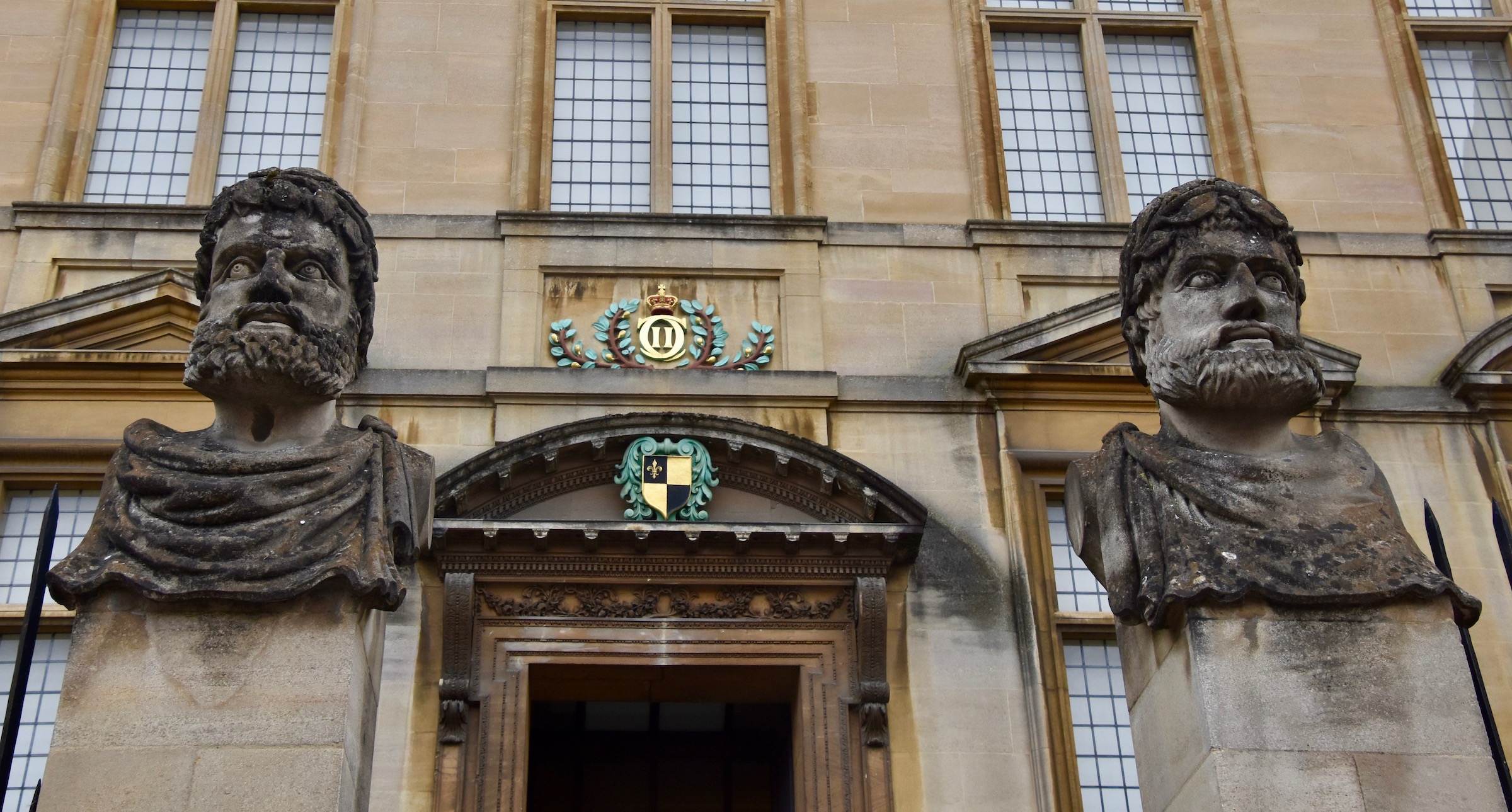
We are now near the end of Broad street and turn right heading toward the Radcliffe Camera, passing the Bodleian Library along the way. Don and I will return to it after the walking tour. On the opposite side is the entrance to New College Lane which is spanned by the Hertford Bridge which connects two halves of Hertford College. Ever since its opening in 1914 it has been referred to as the Bridge of Sighs because of its supposed resemblance to that famous bridge in Venice over which prisoners were led to their place of execution. Hertford students face no worse a fate than possible expulsion.
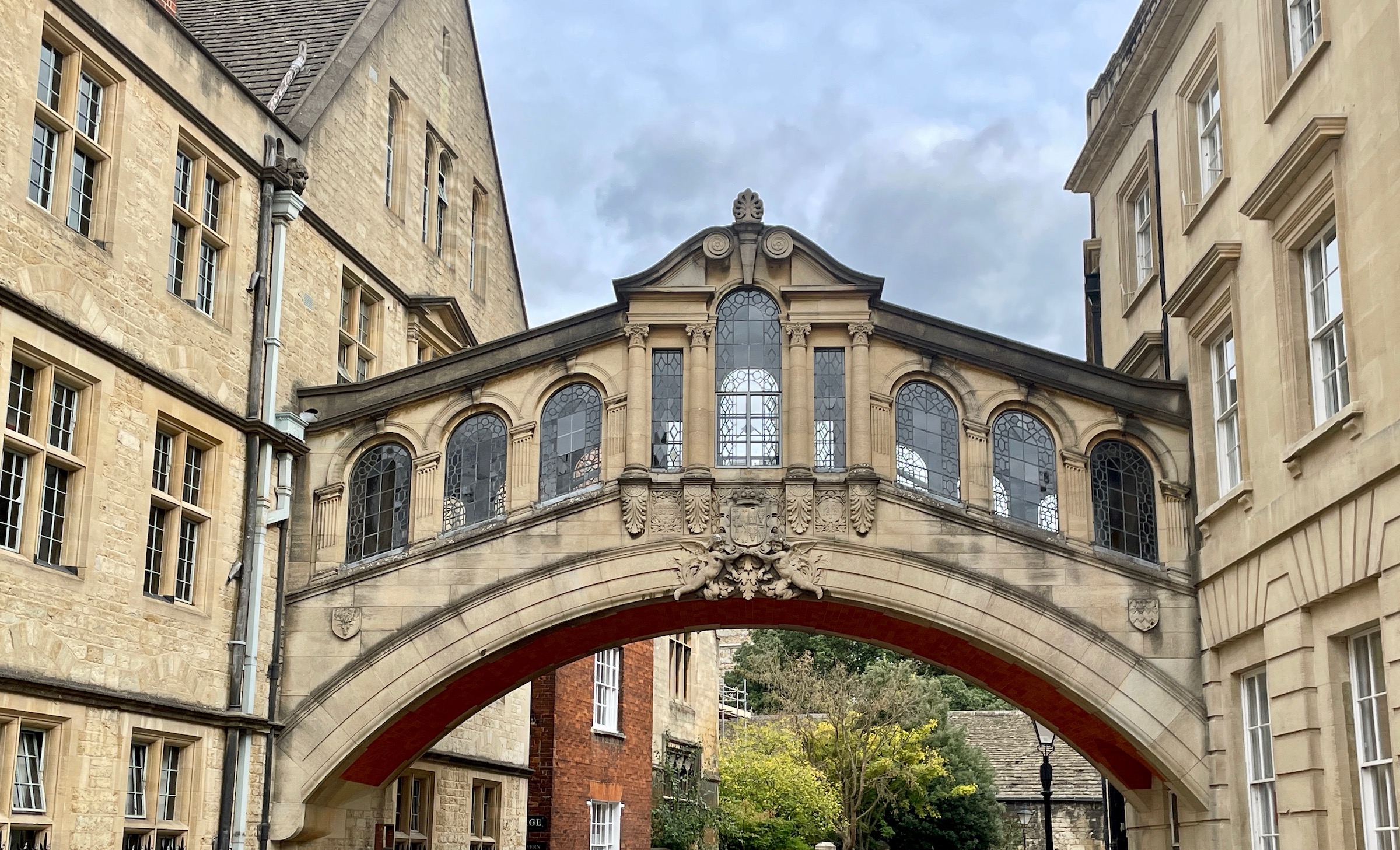
Andrew points out a small lane to the left just between the red brick building and the college that leads to the famous Turf Tavern, another place we shall return to later today. The sign leading to it promises an “Education in Intoxication” and we are both eager to learn.
Also in New College Lane is the former residence of astronomer Edmund Halley who has the world’s most famous comet named after himself; not because he discovered it, but because he correctly predicted its orbit and when it would next return, which incidentally is now 2061.
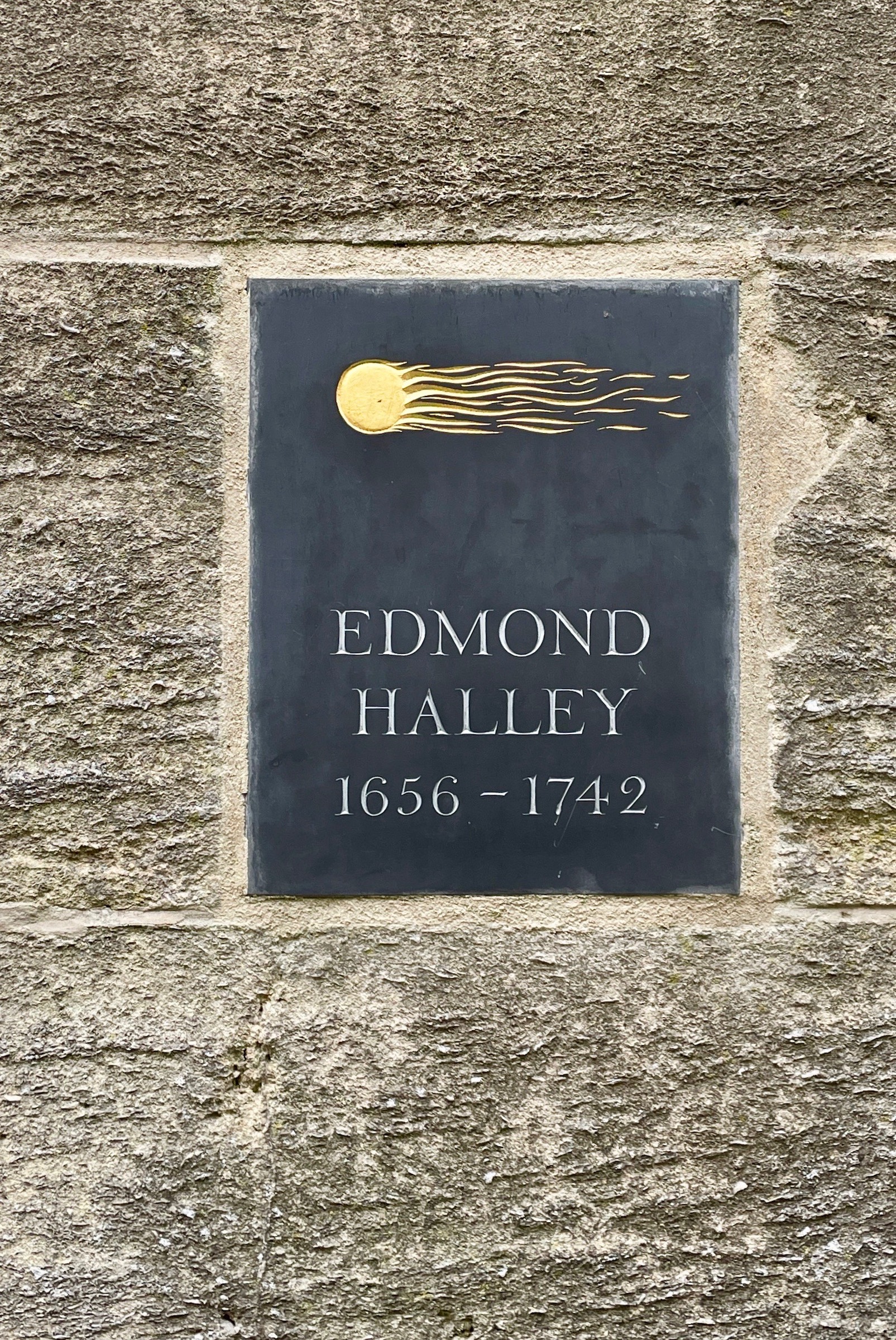
Oxford seems to have an unusual number of strange looking buildings of which the Radcliffe Camera is probably the most notable. It was originally a science library opened in 1749 from funds provided by one James Radcliffe, but has since transitioned into being the reading room for the adjacent Bodleian Library. Camera is simply the latin word for ‘room’. If there is one building that evokes Oxford it is the Radcliffe Camera.
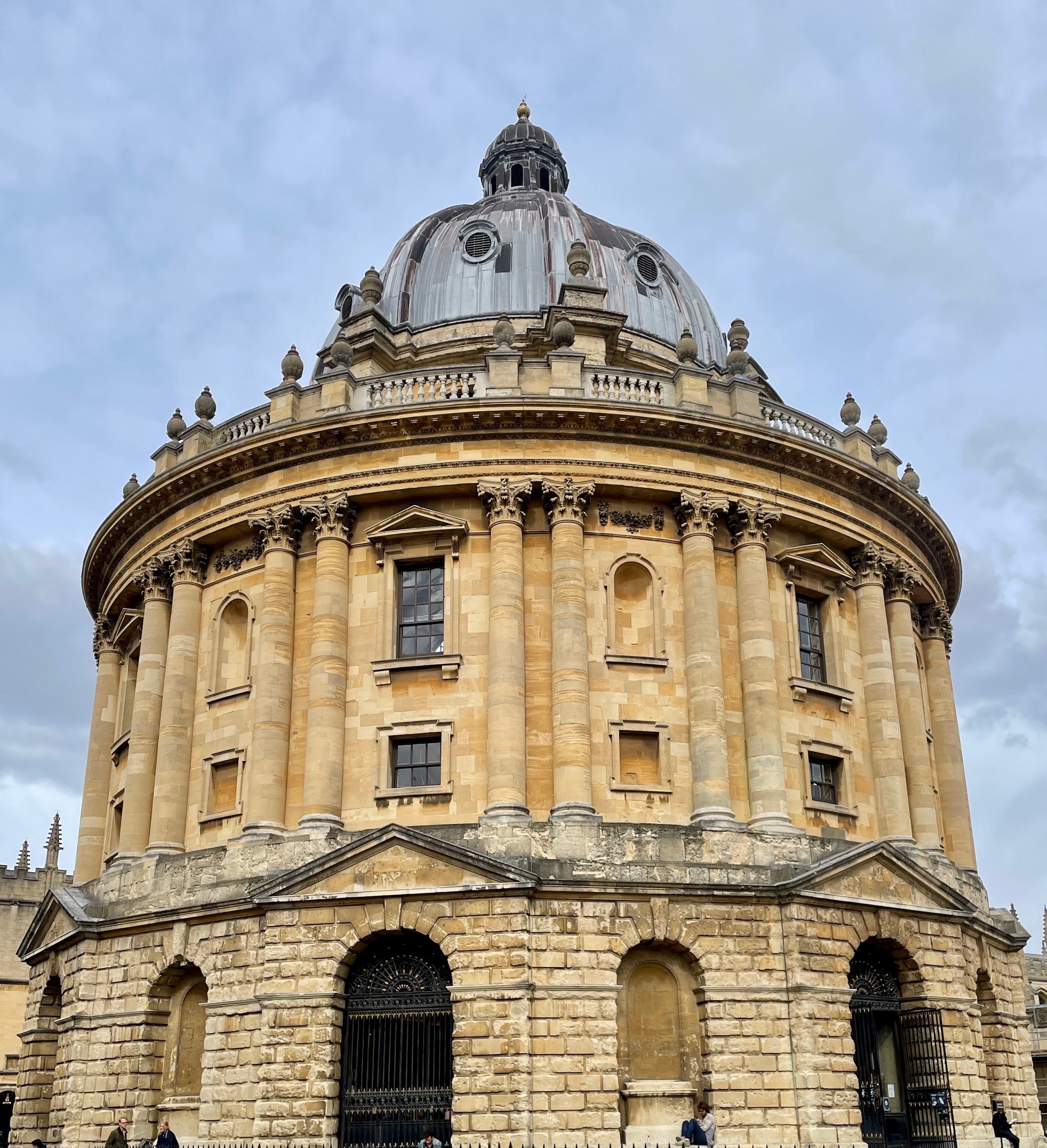
Oxford is also know for its many churches of which University Church of St. Mary the Virgin is one of the finest. It stands on the opposite side of Radcliffe Square with a spire that is one of the finest in England. This church, parts of which date from the 13th century, was the original focal point for Oxford University and it was here that the seat of university government was centred. It is easy to forget that all of the oldest Oxford colleges began as religious institutions and that they were all Catholic. It was in this church that the trial of the Oxford Martyrs was held in 1555. For Don and I the primary interest is that for a small fee we can climb up the spire for the best view in Oxford. We will do that as well after the walking tour is concluded.
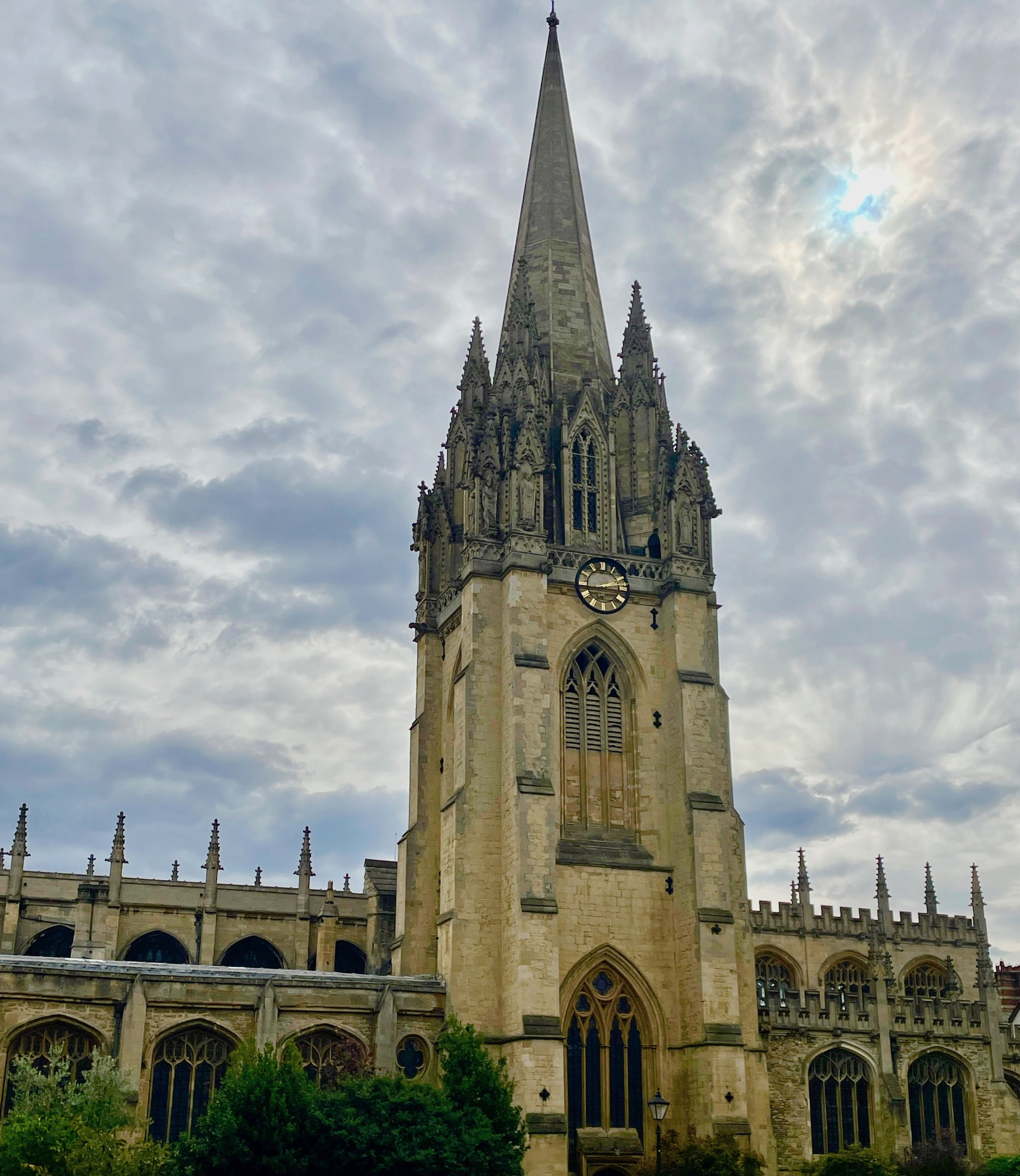
Another literary figure closely associated with Oxford is C.S.Lewis who wrote the seven volume Chronicles of Narnia. Andrew points out an ordinary lamp post that stands in the middle of St. Mary’s Passage between the University Church and High Street. It is alleged to be the inspiration for the lamp post that was the bridge between earth and the fantasy world of Narnia.
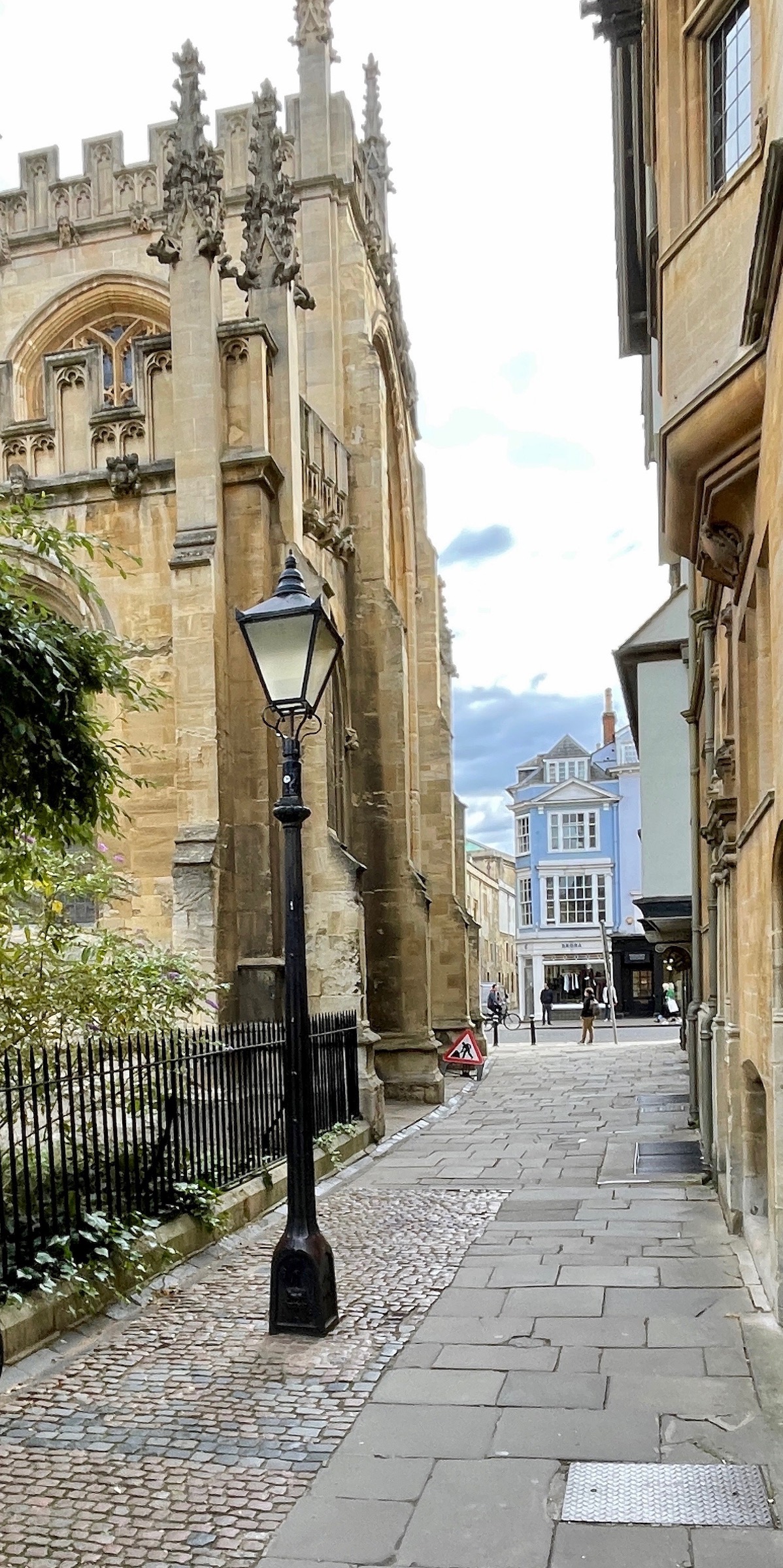
This is reinforced by the fact that only a few steps away is this door which appears to have the face of Aslan the lion carved into it with two satyrs on either side that look like Mr. Tumnus. For some reason I did not get a picture of the door and have inserted this public domain photo instead.
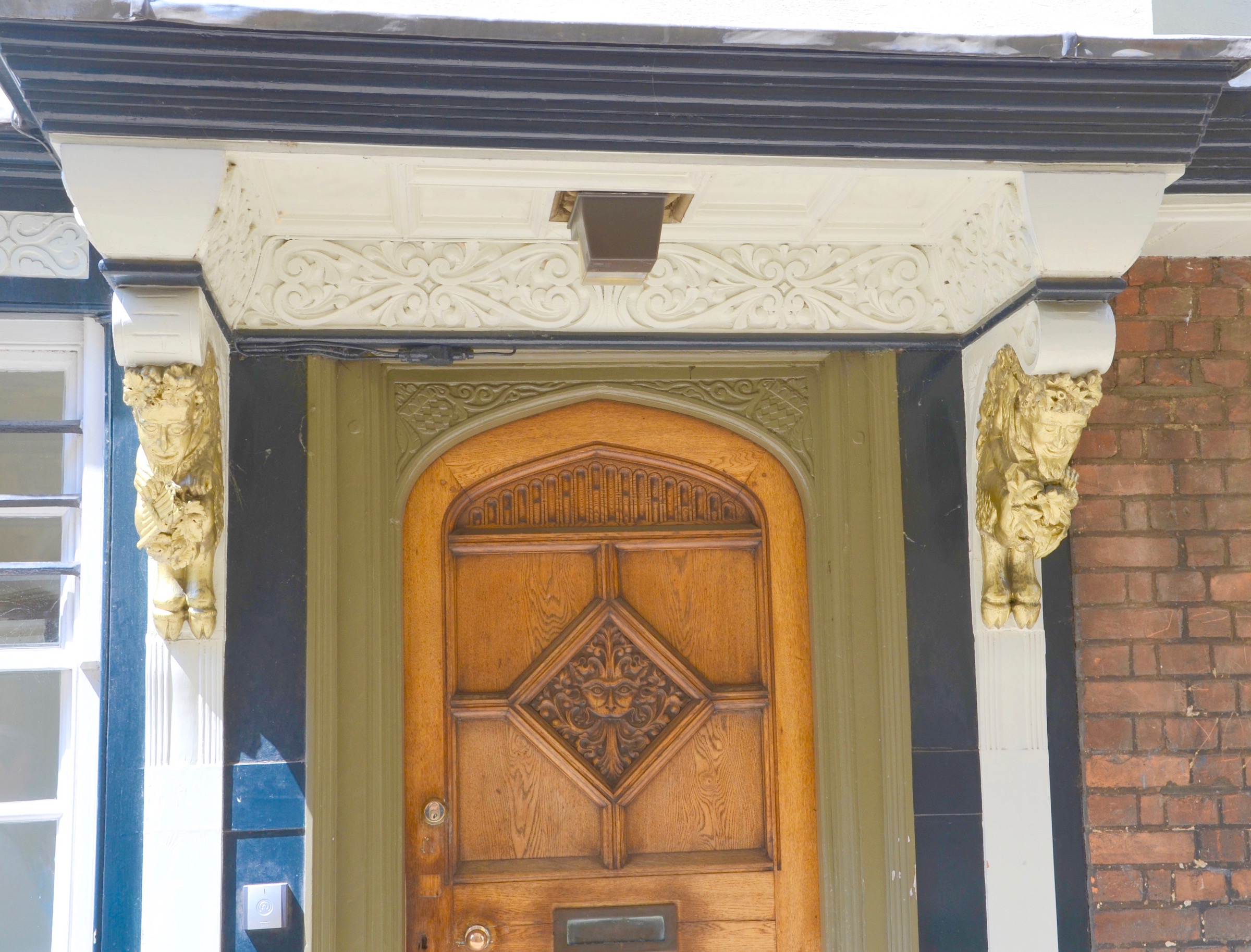
I did however get a closeup of Mr. Tumnus.
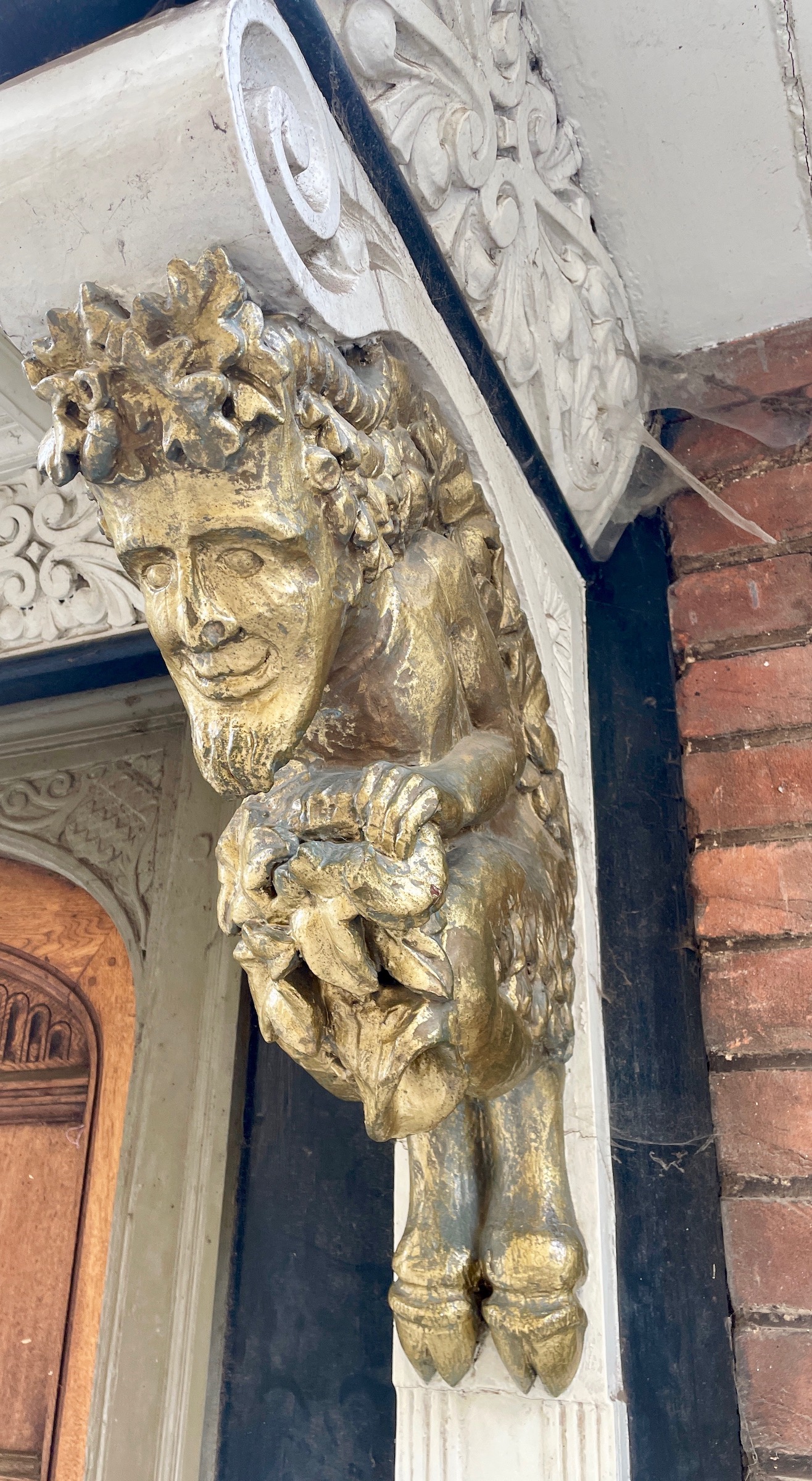
What is very strange to me is that both Tolkien and Lewis were deeply religious men, the former a Catholic and the latter a Protestant. However, their epic fantasies draw deeply from non-Christian sources from all over the world. Frankly, they make their pagan based worlds sound a lot more interesting than the real world of modern Christianity.
We now entered University Church from the High Street entrance and made our way to the balcony for this view of the church nave, which I found surprisingly small considering the exterior dimensions.
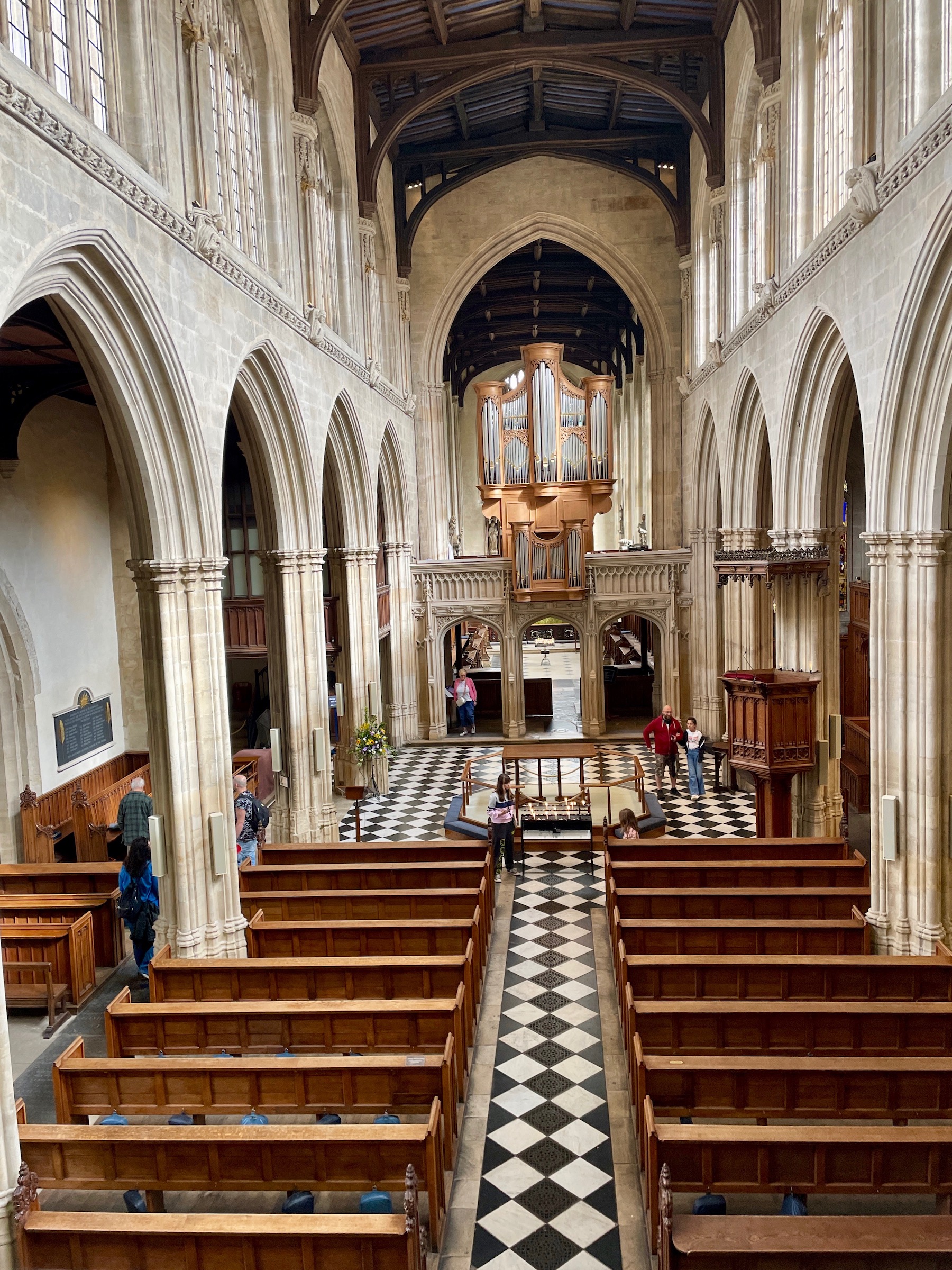
It was time now to say goodbye to Andrew and thank him for his very informative tour of medieval Oxford. Aside from guiding for Oxford Walking Tours Andrew has his own company, Escape to Oxford which he shares with guide Nick Woods. You can contact them through the website link or by calling Andrew at +44 7 555 20 5646.
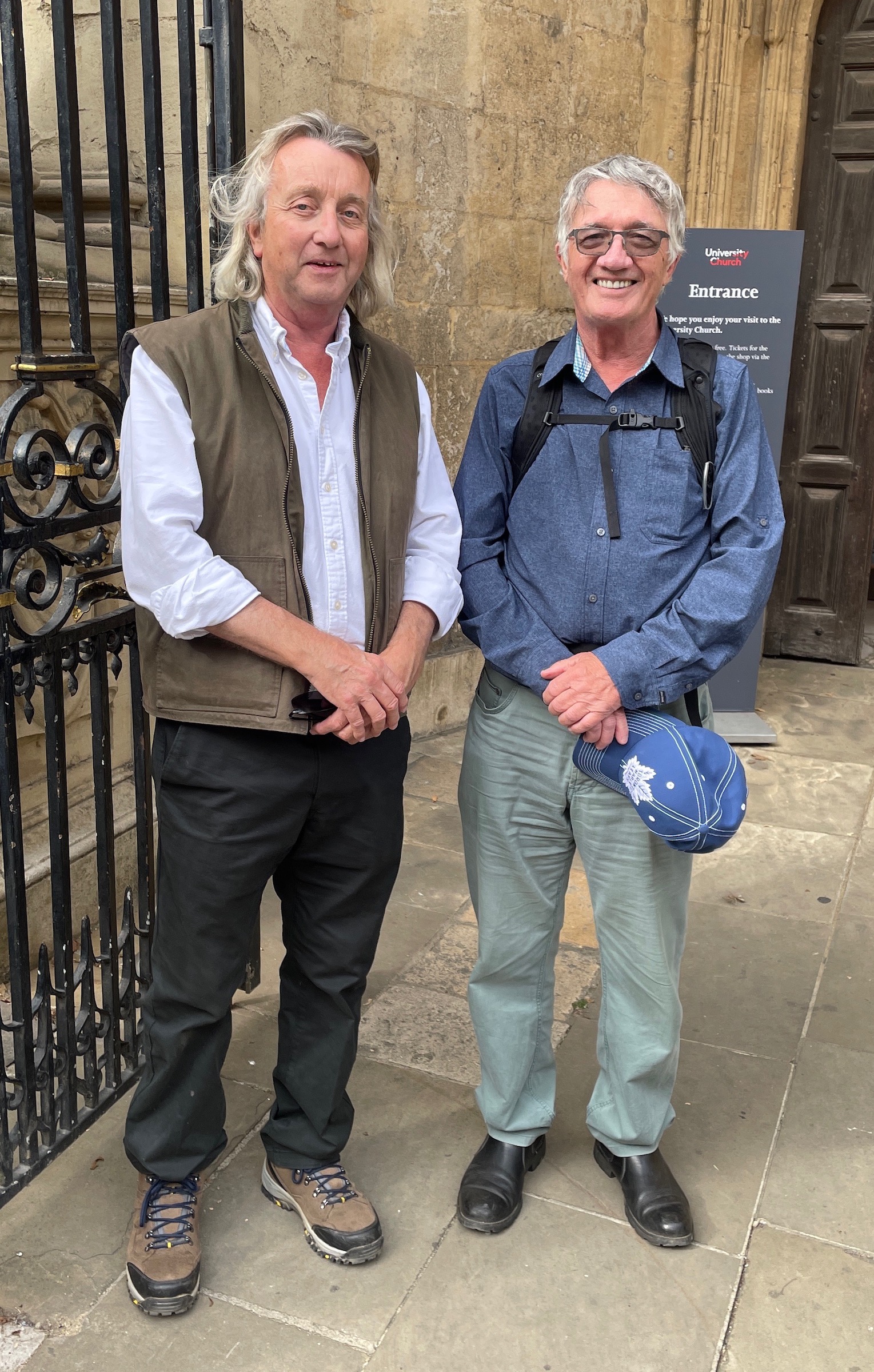
The first thing Don and I did after parting ways with Andrew was return to University Church and take the 127 steps to the tower. We were the only ones up there and had these spectacular views of Oxford.
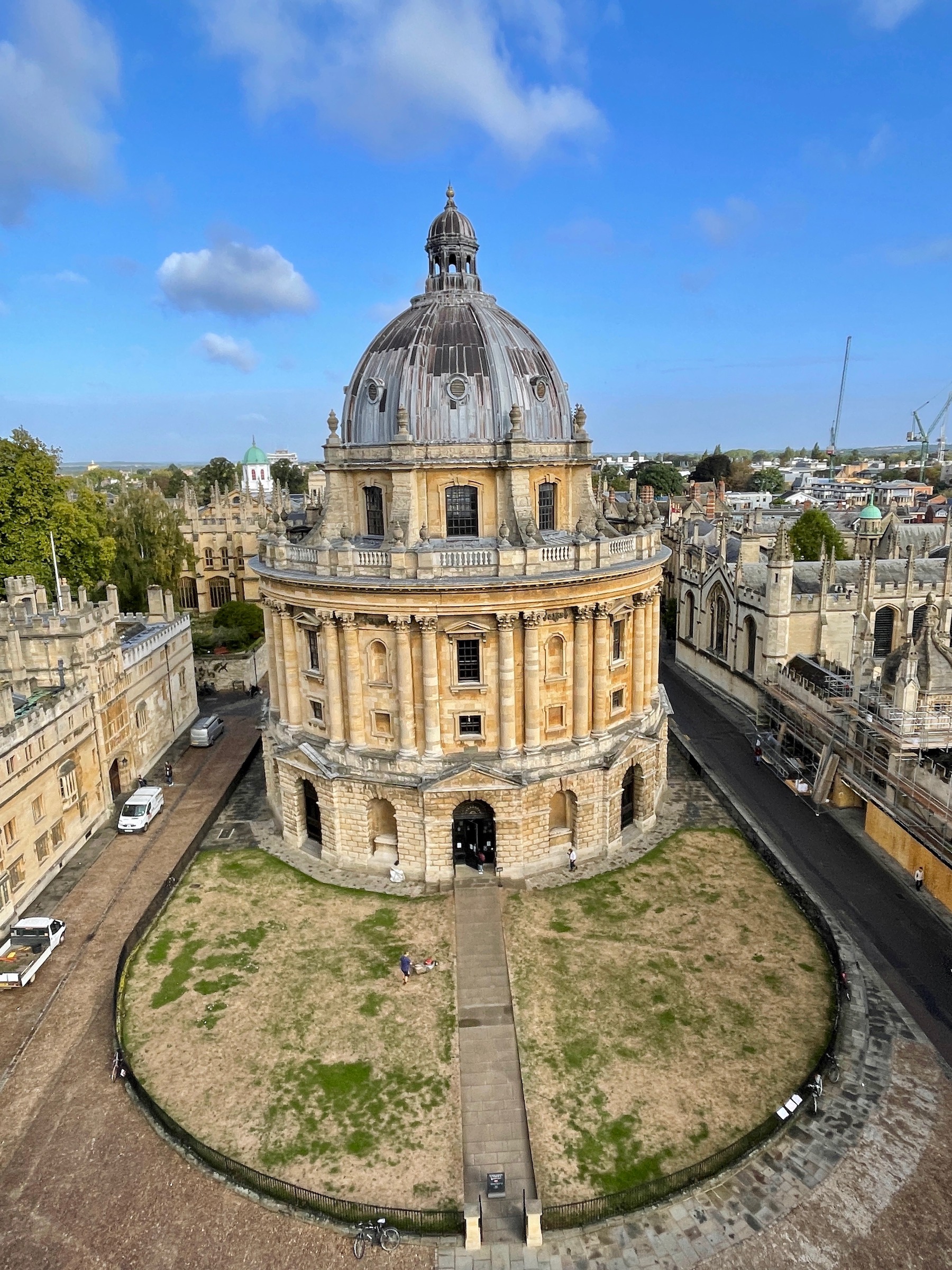
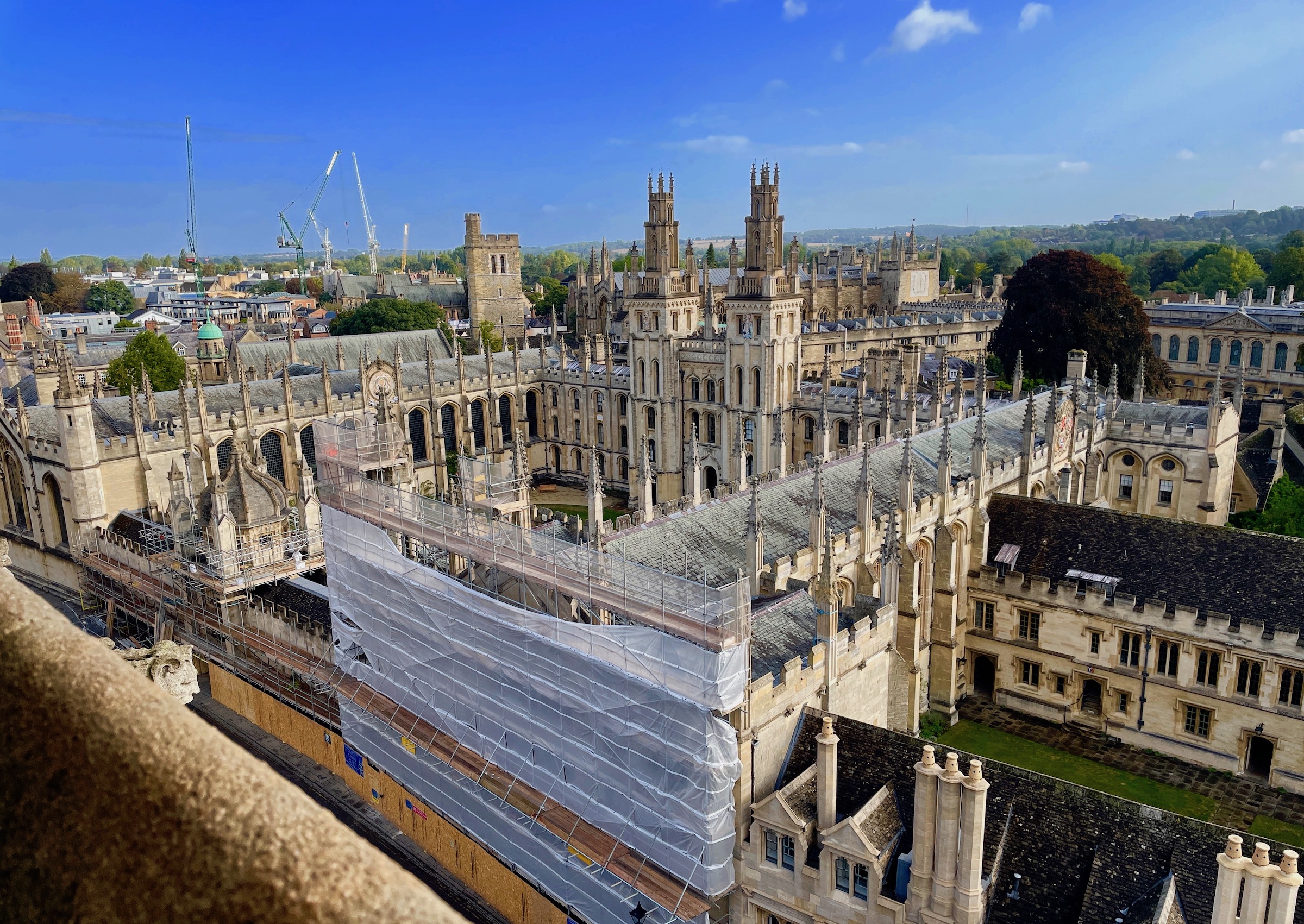
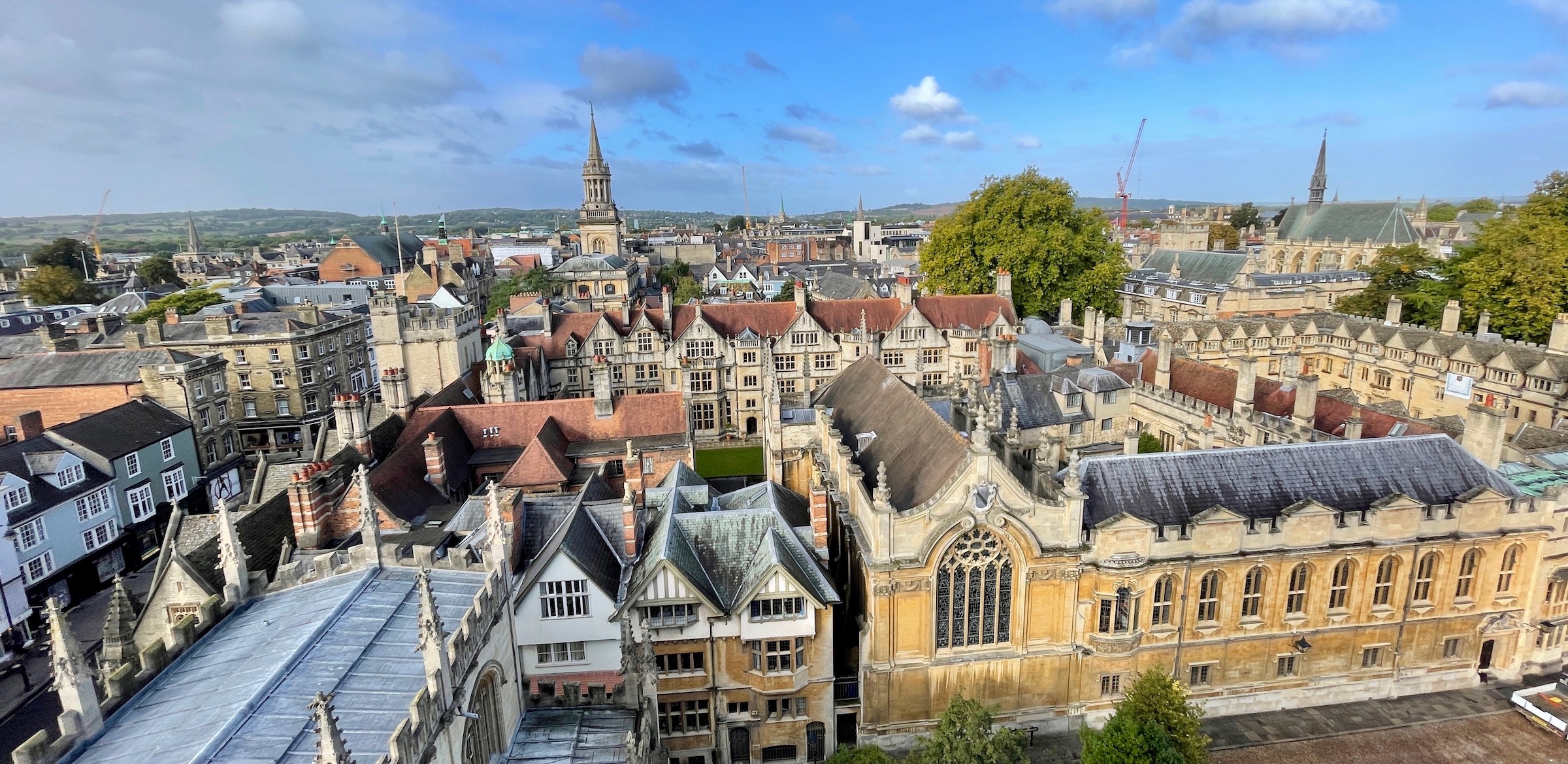
And of course my proof that I actually made the climb. Note the figure behind me. It is one of a dozen statues of various religious figures, most unidentified, that originally date from the 13th century athough most have been touched up or resculpted since then. All of the figures stand over some type of sinner or creature that is being crushed by the weight of the one true religion. Here is a link to all of them.
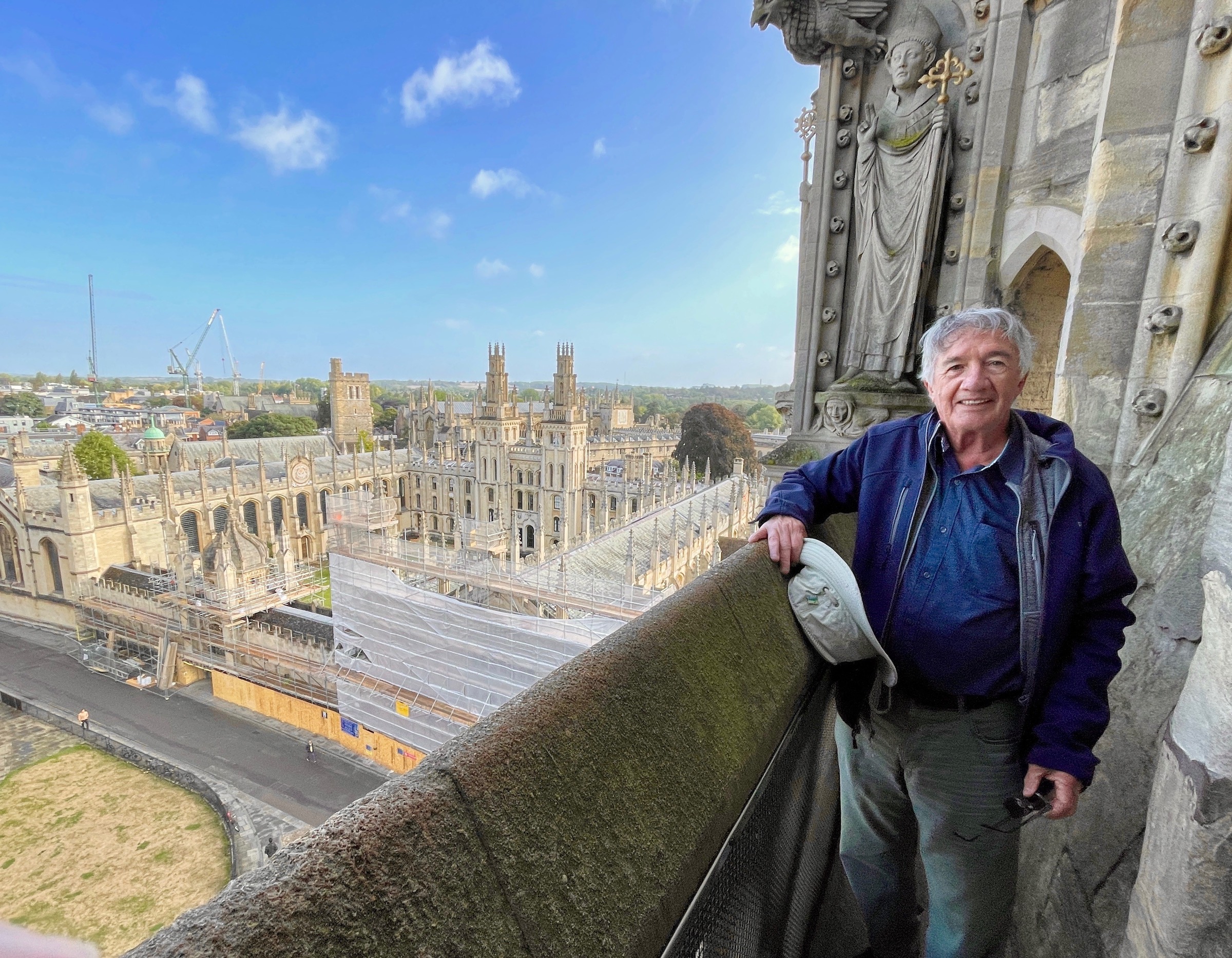
The Bodleian Library
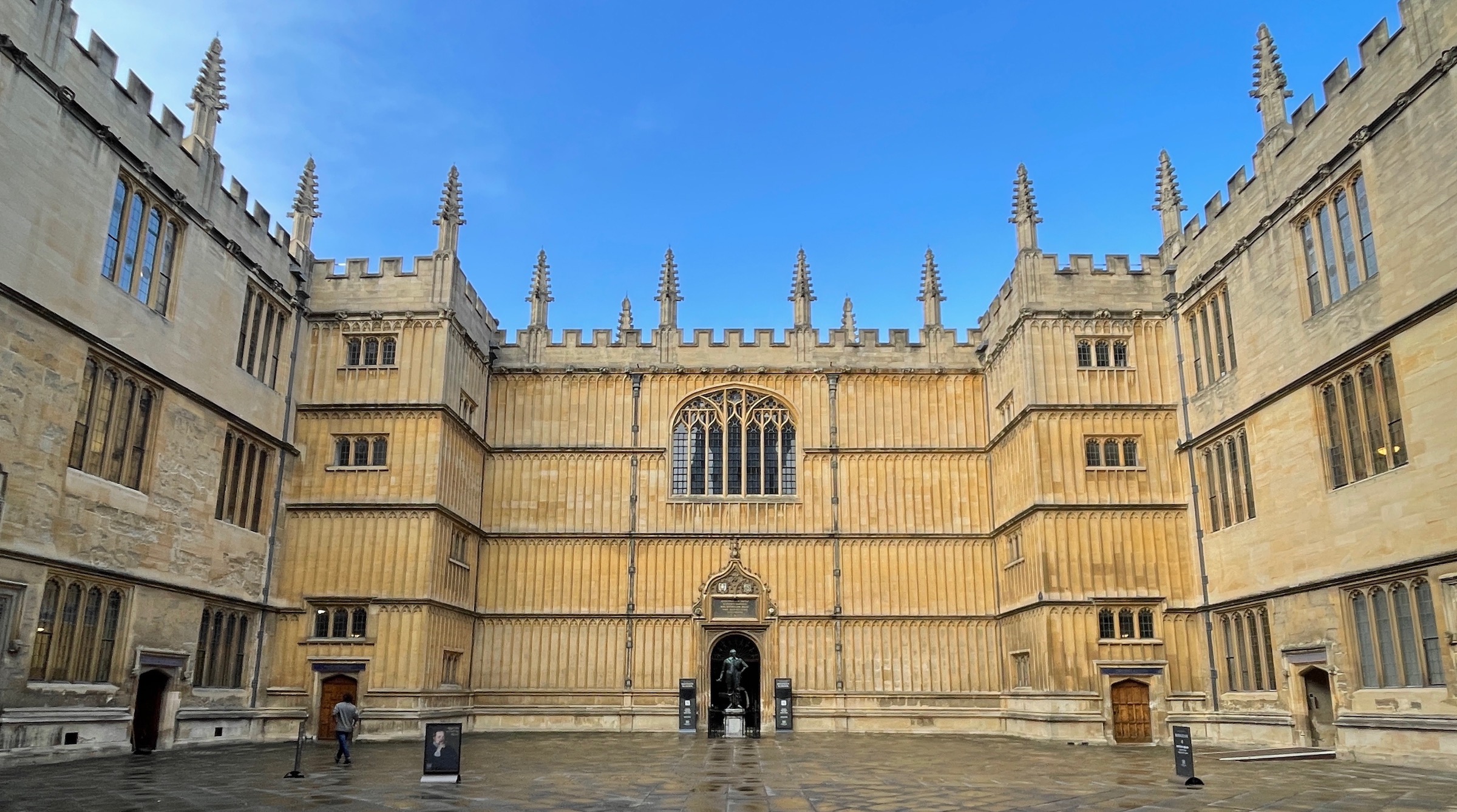
The Bodleian Library is actually a collection of twenty-seven campus wide libraries that collectively house over 12 million books, manuscripts and other material. However, for the purposes of tourism versus scholasticism, it is this building above, the Bodleian Old Library, that people want to see. Inside you will find the Divinity School and Duke Humfrey’s Library which you can only visit on a pre-booked guided tour which Don and I have booked. We are a bit early for our allotted time and I noticed a series of doors leading into the four walls of the quad in front of the library entrance. Each of these leads to or at least once did, various schools or what we would call faculties or departments. These include Music, Astronomy, Rhetoric, Logic, Metaphysics, Hebrew, Greek, Mathematics, Grammar, History and Moral Philsophy. Each door has two heads, one on each side and they are all quite different. Despite my best efforts I cannot find a list of who these heads are meant to represent, but I did create a gallery of all of them. I’m pretty sure the philosophers are Aristotle and Socrates, but the rest I have no clue.
- Entrance to the North Gate 2
- Over the North Entrance
- School of Grammar
- School of History
- School of Languages
- School of Logic 2
- School of Logic
- School of Mathematics
- School of Metaphysics 2
- School of Moral Philosophy 2
- School of Moral Philosophy
- School of Music
- South Gate
- Unknown School 2
- Unknown School
As you can see some the heads are clearly much newer than others and more modern in appearance.
The entrance to the Bodleian Old Library has this statue of William Herbert, Duke of Pembroke which was sculpted by Hubert Le Sueur on the 1600’s. Originally it stood at the family seat in Wilton House, but was given to the Bodleian Library in 1723 in recognition of Pembroke’s role as Chancellor of Oxford University, founder of Pembroke College and a donor of many of the libraries earliest manuscripts. He is equally well known as being a patron of William Shakespeare who dedicated his first folio to him. He is also speculated to be the ‘fair youth’ to whom many of the Bard’s sonnets are directed.
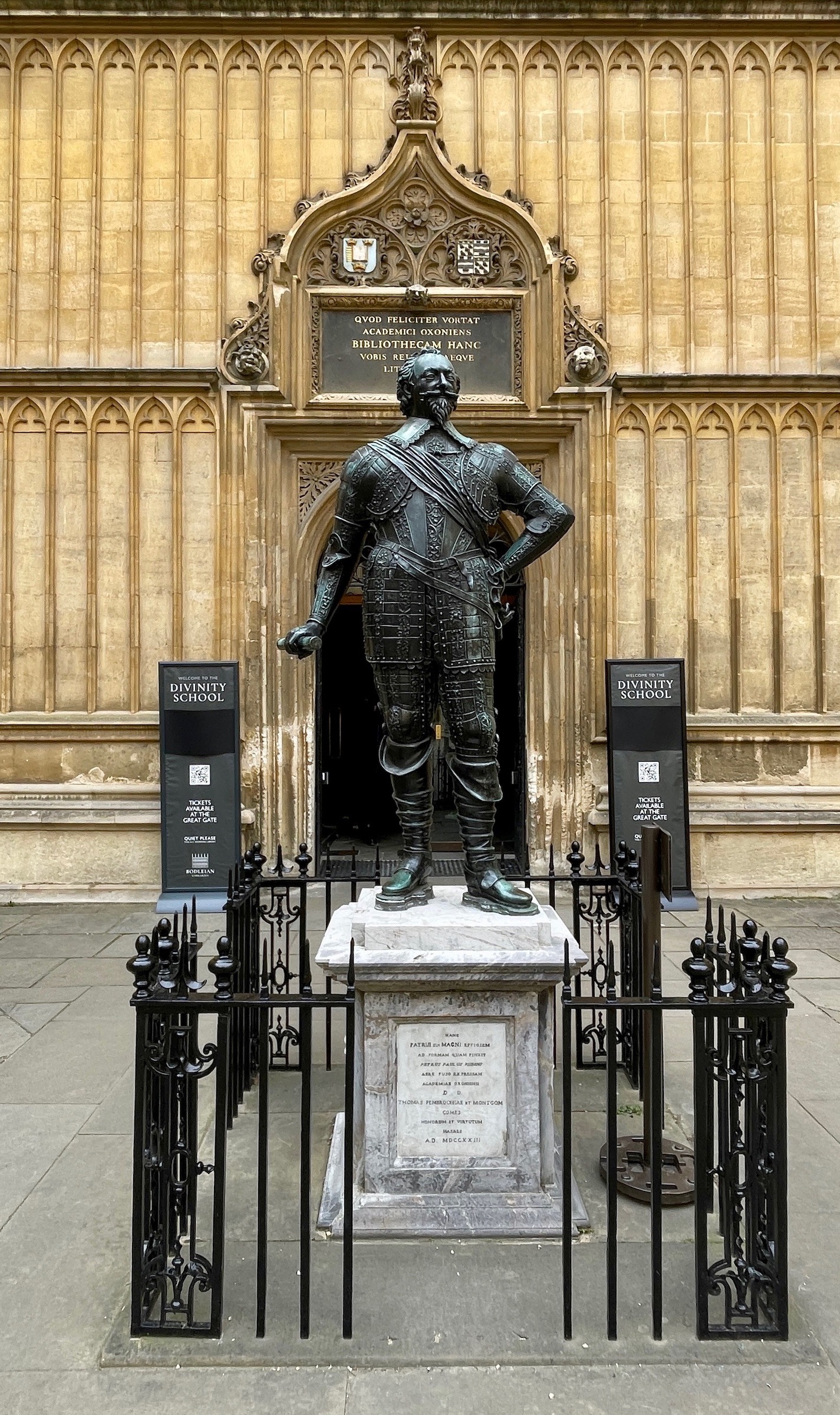
The visit to the Bodleian Old Library is restricted to two areas, the Divinity School and the Duke Humphrey’s Library. Photographs are only allowed in the Divinity School which is indeed a stunning Gothic Perpendicular style room (that hardly seems a grand enough term) with a fantastic ceiling that features 455 different bosses at the rib intersections of the vaulted roof.
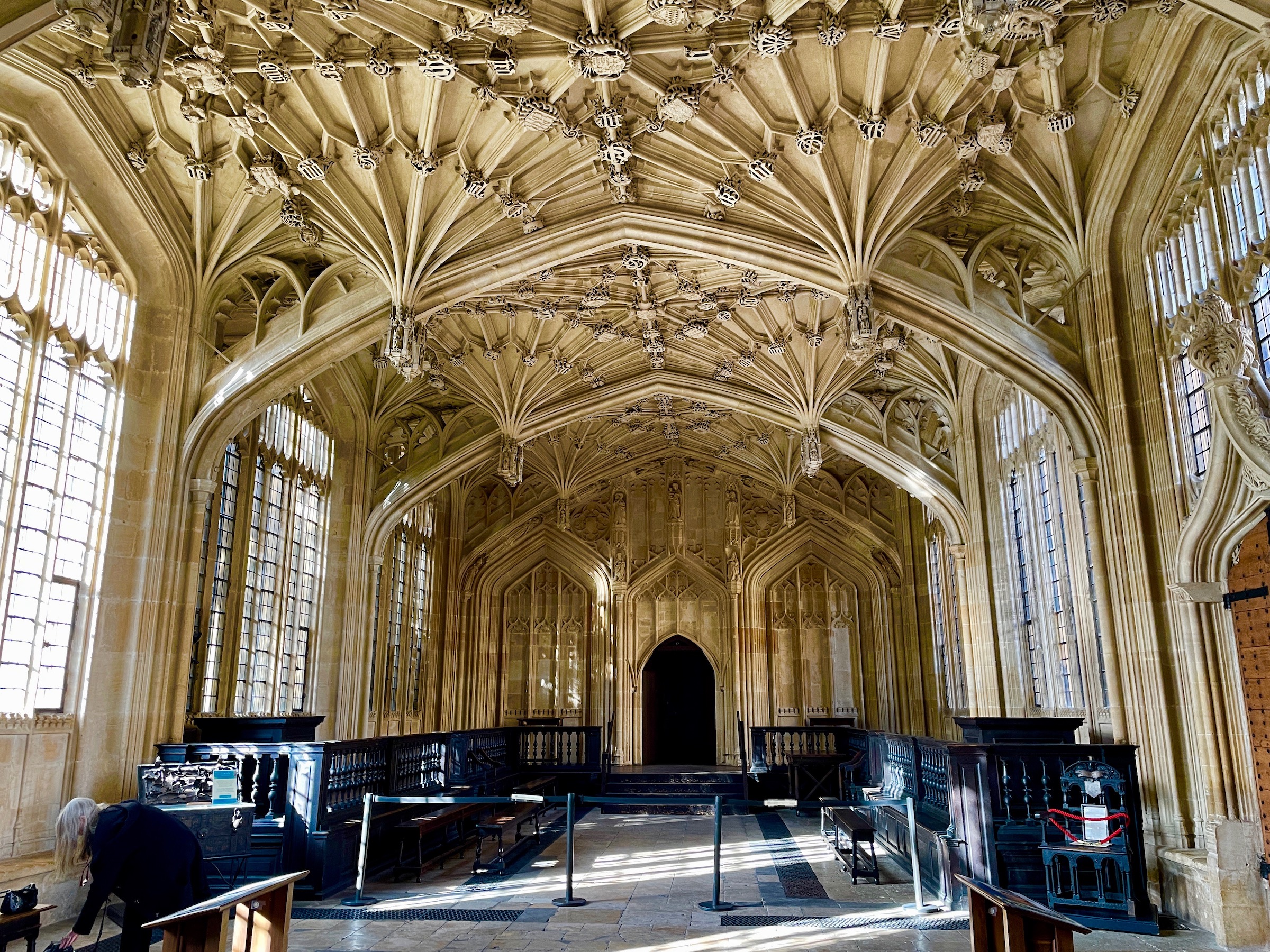
Here’s a closer look at some of these bosses that date back over 540 years.
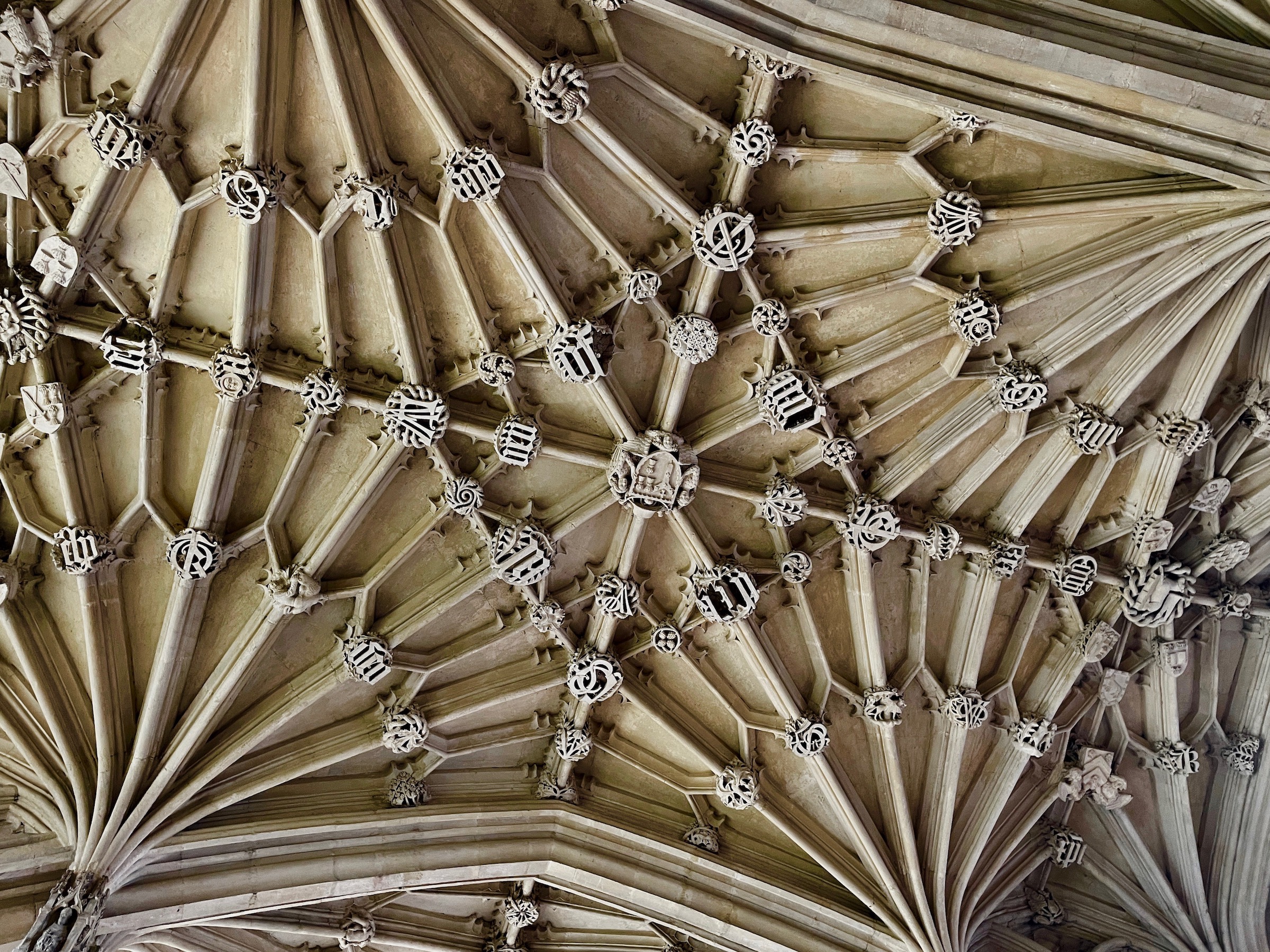
The Divinity School is the oldest existing building in Oxford where lectures, thesis defences and other scholarly activities took place. Our guide pointed out a place where a student would stand for hours to be peppered with questions from his tutors to determine if he had earned the distinction of being awarded a degree.
If this room looks familiar it is because it features as the Hogwarts Infirmary in the first film and shows up in a number of scenes in the next three films.
From the Divinity School we are led upstairs to the Duke Humfrey’s Library which is the oldest reading room in Oxford. It was started from a gift of some 281 books by the Duke of Gloucester, a son of Henry IV. That might not seem like a lot, but this was before the printing press and today the three books that were not destroyed by the Puritans are among the library’s most cherished possessions. It looks every bit as you would expect an ancient library to as this public domain photograph illustrates.
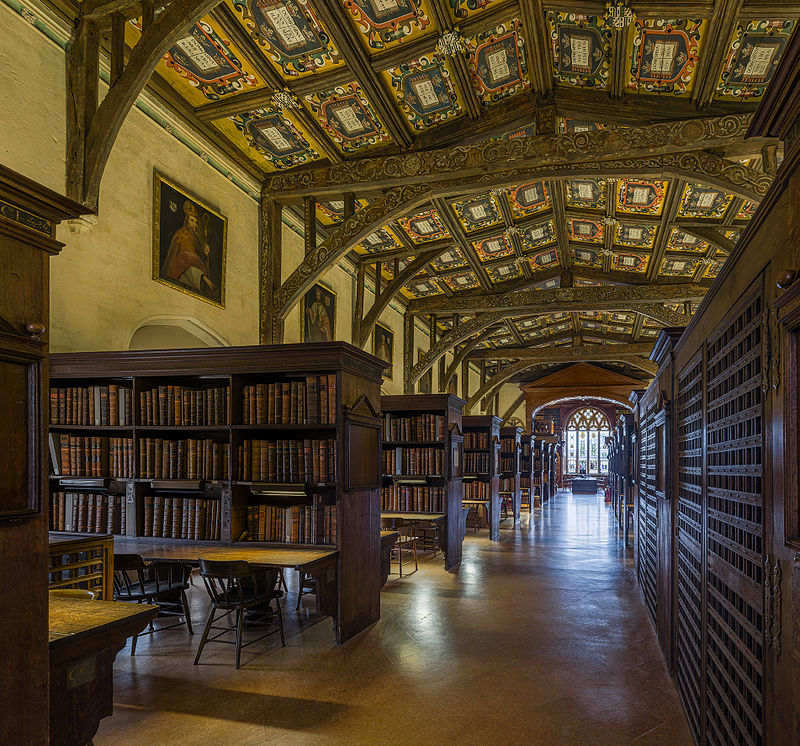
Again if the library seems familiar, it is because Harry Potter wandered its stacks in Harry Potter and the Philosopher’s Stone.
Well it’s been quite a day for Don and I and it’s time for some R&R so we head the short distance to the Turf Tavern which has been entertaining guests since 1831. However, the building just outside the walls of Oxford has been here since the 1300’s and has been a magnet for celebrities for ages. It is allegedly the place where Bill Clinton famously ‘did not inhale’ that joint.
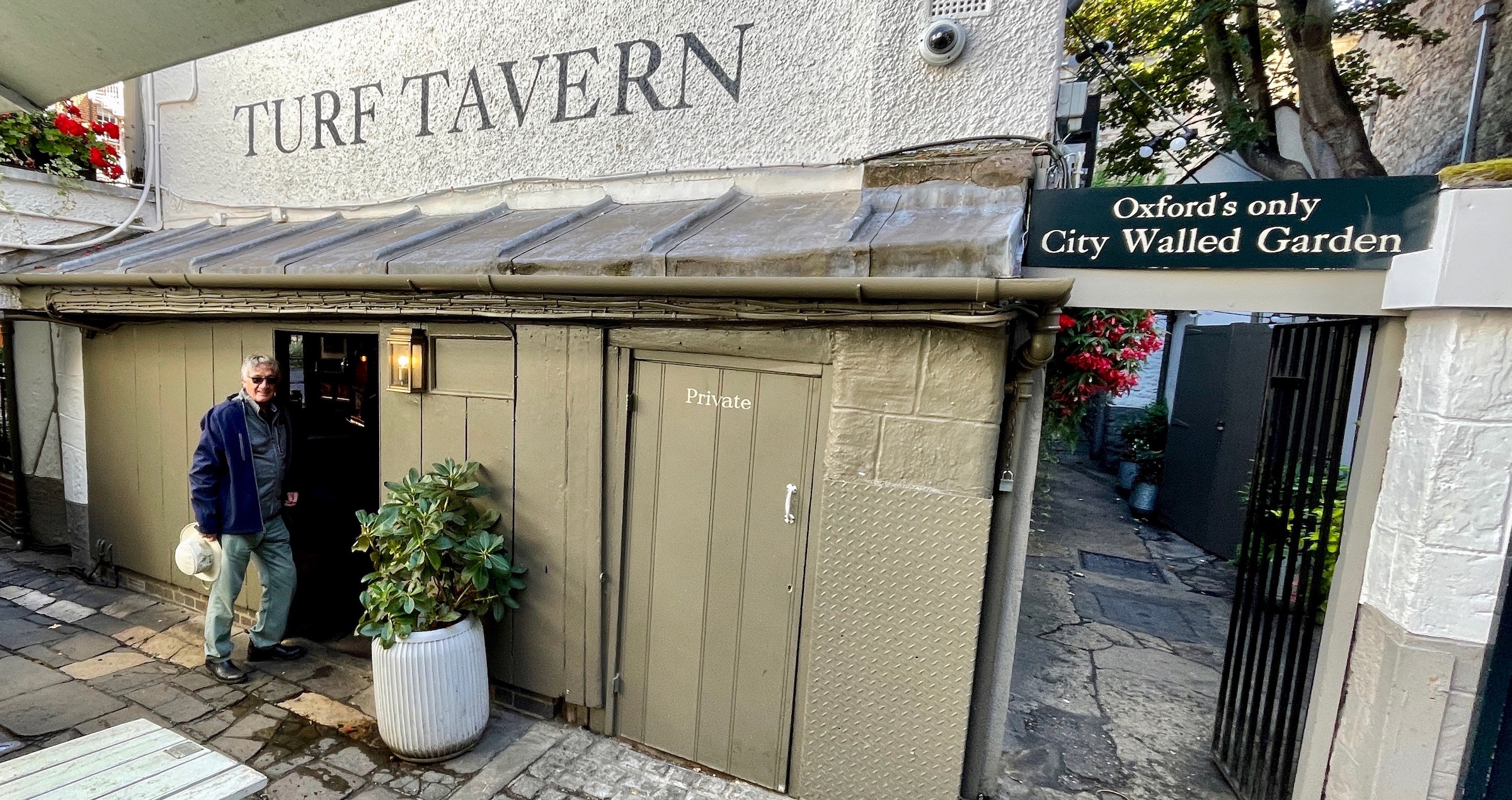
This is the Jane Burden room adorned with a face familiar to any student of the Pre-Raphaelite movement. She grew up only a few feet away from the Turf Tavern and became the embodiment of female beauty to artists like Dante Gabriel Rosetti and her husband William Morris. Her presence is very much alive in this intriguing room.
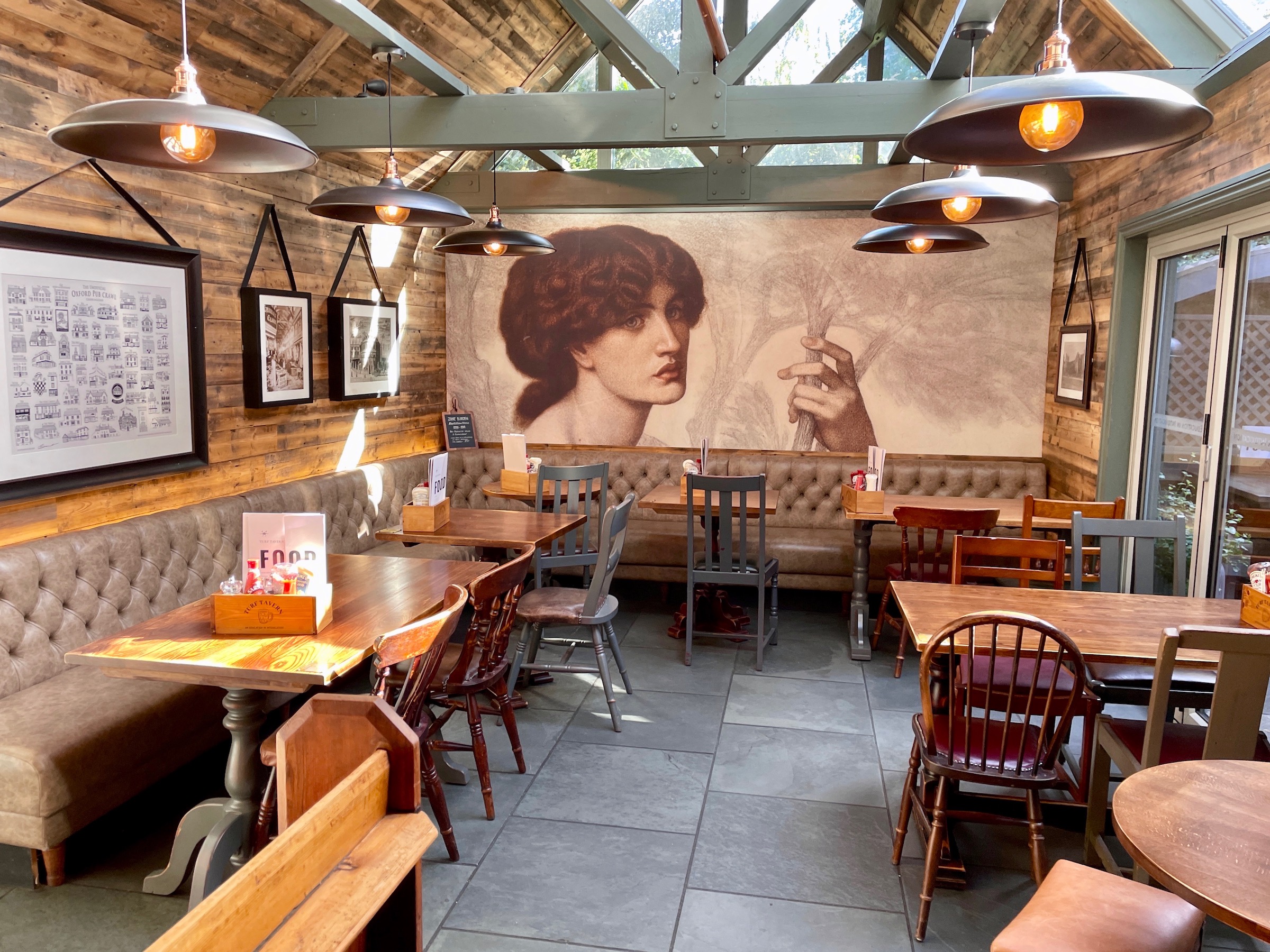
With a pint of cask ale in hand, Don and I say goodbye from Oxford. The next post will find us in Scotland where we will join six other buds in a week or so of golf, drinking and bullshitting. Hope you’ll join us.


